Animal Rights: Definition, Issues, and Examples
Animal rights advocates believe that non-human animals should be free to live as they wish, without being used, exploited, or otherwise interfered with by humans.

T he idea of giving rights to animals has long been contentious, but a deeper look into the reasoning behind the philosophy reveals ideas that aren’t all that radical. Animal rights advocates want to distinguish animals from inanimate objects, as they are so often considered by exploitative industries and the law.
The animal rights movement strives to make the public aware of the fact that animals are sensitive, emotional , and intelligent beings who deserve dignity and respect. But first, it’s important to understand what the term "animal rights" really means.


What are animal rights?
Animal rights are moral principles grounded in the belief that non-human animals deserve the ability to live as they wish, without being subjected to the desires of human beings. At the core of animal rights is autonomy, which is another way of saying choice . In many countries, human rights are enshrined to protect certain freedoms, such as the right to expression, freedom from torture, and access to democracy. Of course, these choices are constrained depending on social locations like race, class, and gender, but generally speaking, human rights safeguard the basic tenets of what makes human lives worth living. Animal rights aim to do something similar, only for non-human animals.
Animal rights come into direct opposition with animal exploitation, which includes animals used by humans for a variety of reasons, be it for food , as experimental objects, or even pets. Animal rights can also be violated when it comes to human destruction of animal habitats . This negatively impacts the ability of animals to lead full lives of their choosing.
Do animals have rights?
Very few countries have enshrined animal rights into law. However, the US and the UK do have some basic protections and guidelines for how animals can be treated.
The UK Sentience Bill
In 2021, the United Kingdom's House of Commons introduced the Animal Sentience Bill . If passed, this bill would enshrine into law that animals are, in fact, sentient beings, and they deserve humane treatment at the hands of humans. While this law would not afford animals full autonomy, it would be a watershed in the movement to protect animals—officially recognizing their capacity to feel and to suffer, and distinguishing them from inanimate objects.
The US Animal Welfare Act
In 1966, the United States passed the Animal Welfare Act . While it is the biggest federal legislation addressing the treatment of animals to date, its scope is fairly narrow—the law excludes many species, including farmed animals , from its protections. The law does establish some basic guidelines for the sale, transport, and handling of dogs, cats, rabbits, nonhuman primates, guinea pigs, and hamsters. It also protects the psychological welfare of animals who are used in lab experiments, and prohibits the violent practices of dogfighting and cockfighting. Again, this law does not recognize the rights and autonomy of animals—or even their ability to feel pain and suffer—but it does afford non-human animals some basic welfare protections .
What are some examples of animal rights?
While few laws currently exist in the UK or US that recognize or protect animals' rights to enjoy lives free from human interference, the following is a list of examples of animal rights that could one day be enacted:
- Animals may not be used for food.
- Animals may not be hunted.
- The habitats of animals must be protected to allow them to live according to their choosing.
- Animals may not be bred.
What's the difference between animal welfare and animal rights?
Animal rights philosophy is based on the idea that animals should not be used by people for any reason, and that animal rights should protect their interests the way human rights protect people. Animal welfare , on the other hand, is a set of practices designed to govern the treatment of animals who are being dominated by humans, whether for food, research, or entertainment.
Do animals need rights? Pros and cons
The idea of giving animals rights tends to be contentious, given how embedded animal products are within societies such as the United States. Some people, including animal activists, believe in an all-or-nothing approach, where animal rights must be legally enshrined and animals totally liberated from all exploitation. On the other end of the spectrum are people whose livelihoods depend upon animal-based industries. Below are some arguments both in favor of and opposing animal rights.
Arguments in favor of animal rights
Should the rights of animals be recognized, animal exploitative industries would disappear, as would the host of environmental problems they cause, including water pollution, air pollution, greenhouse gas emissions, and deforestation.
Halting the widespread use of animals would also eliminate the systematic cruelty and denial of choice that animal industries perpetuate. The physical and psychological pain endured by animals in places like factory farms has reached a point many consider to be unacceptable , to say the least. Animals are mutilated by humans in several different ways, including castrations, dehorning, and cutting off various body parts, usually without the use of anesthetic.
“ Many species never see the outdoors except on their way to the slaughterhouse.
As their name suggests, concentrated animal feeding operations (CAFOs) pack vast numbers of animals in cramped conditions, often forcing animals to perpetually stand in their own waste. Many species—including chickens, cows, and pigs—never see the outdoors except on their way to the slaughterhouse. Recognizing animal rights would necessitate stopping this mistreatment for good.
Arguments against animal rights
Most arguments against animal rights can be traced back to money, because animal exploitation is big business. Factory farming for animal products is a multi-billion-dollar industry. JBS, the world’s largest meatpacker, posted $9 billion in revenue for the third quarter of 2020 alone.
A lesser-known, yet also massive, industry is that which supplies animals for laboratories. The US market for lab rats (who are far less popular than mice for experiments) was valued at over $412 million in 2016. Big industrial producers of animals and animal products have enough political clout to influence legislation—including passing laws making it illegal to document farm conditions—and to benefit from government subsidies.
Many people depend upon animal exploitation for work. On factory farms, relatively small numbers of people can manage vast herds or flocks of animals, thanks to mechanization and other industrial farming techniques. Unfortunately, jobs in industrial meatpacking facilities are also known to be some of the most dangerous in the US. Smaller farmers coming from multi-generational farming families more directly depend upon using animals to make a living and tend to follow welfare standards more judiciously. However, smaller farms have been decreasing in number, due to the proliferation of factory farms against which they often cannot compete.
Although people may lose money or jobs in the transition to animal alternatives, new jobs can be created in the alternative protein sector and other plant-based industries.
When did the animal rights movement begin in the US?
The modern day animal rights movement in the United States includes thousands of individuals and a multitude of groups who advocate for animals in a variety of ways—from lobbying legislators to support animal rights laws, to rescuing animals from situations of abuse and neglect. While individuals throughout history have believed in and fought for animal rights, we can trace back the modern, US-based animal rights movement to the founding of the American Society for the Prevention of Cruelty to Animals (ASPCA) in 1866. The group's founder, Henry Burgh , believed that animals are "entitled to kind and respectful treatment at the hands of humans and must be protected under the law." The organization worked with the New York City government to pass and enforce anti-cruelty laws that prevented the abuse of carthorses and provided care for injured horses. Since then, the ASPCA has expanded its advocacy across different non-human animal species—including farmed animals—and many more animal protection groups have sprung up, both locally and nationwide. Currently, there are over 40,000 non-profit organizations identified as animal groups in the US.
Why are animal rights important?
Animal rights are important because they represent a set of beliefs that counteract inaccurate yet long-held assumptions that animals are nothing more than mindless machines—beliefs popularized by western philosopher Rene Descartes in the 17th century. The perception of animals as being unthinking, unfeeling beings justified using them for human desires, resulting in today’s world where farmed mammals outnumber those in the wild, and the majority of these farmed animals are forced to endure harsh conditions on factory farms.
“ Farmed mammals outnumber those in the wild.
But the science is increasingly clear: The animals we eat ( pigs, chickens, cows ), the animals we use in laboratories ( mice and rats ), the animals who provide us with clothing , and those whose backs we ride upon have all been found to possess more cognitive complexity, emotions, and overall sophistication than has long been believed. This sophistication renders animals more susceptible not only to physical pain but also to the psychological impacts caused by the habitual denial of choice. Awareness of their own subjugation forms sufficient reasoning to rethink the ways animals are treated in western societies.
The consequences of animal rights
Currently, laws in the US and UK are geared toward shielding animals from cruelty, not giving them the same freedom of choice that humans have. (Even these laws are sorely lacking, as they fail to protect livestock and laboratory animals.) However, the animal rights movement can still have real-world consequences. Calls for animal liberation from places like factory farms can raise public awareness of the poor living conditions and welfare violations these facilities perpetuate, sometimes resulting in stronger protections, higher welfare standards , and decreasing consumer demand. Each of these outcomes carries economic consequences for producers, as typically it is more expensive for factory farms to provide better living conditions such as more space, or using fewer growth hormones which can result in lower production yields.
Of course, should the animal rights movement achieve its goals , society would look much different than it does today. If people consume more alternative sources of protein, such as plant-based or lab-grown meat, the global environment would be far less impacted. Clothing would be made without leather or other animal products; alternative sources, such as pineapple leather created from waste products from the pineapple industry, could replace toxic tanneries. The fur industry is being increasingly shunned, with fashion labels rejecting fur in favor of faux materials. Ocean ecosystems would be able to recover, replenishing fish populations and seafloor habitats. Today these are razed by bottom trawling fishing, resulting in the clear-cutting of corals that can be thousands of years old .
How you can advocate for animals
A world in which animals are free from human exploitation still seems far off, but we can make choices that create a kinder world for animals, every day. We can start by leaving animals off our plate in favor of plant-based alternatives—a choice that recognizes animals as the sentient beings that they are, and not products for consumption.
When we come together, we can also fight for better protections for animals in the US and around the world. There's a robust movement to hold corporations accountability and end the cruelty of factory farming—an industry which causes immense amount of suffering for billions of animals. If you want to help end this suffering and spread compassion for animals, join our community of online animal activists and take action .
More like this
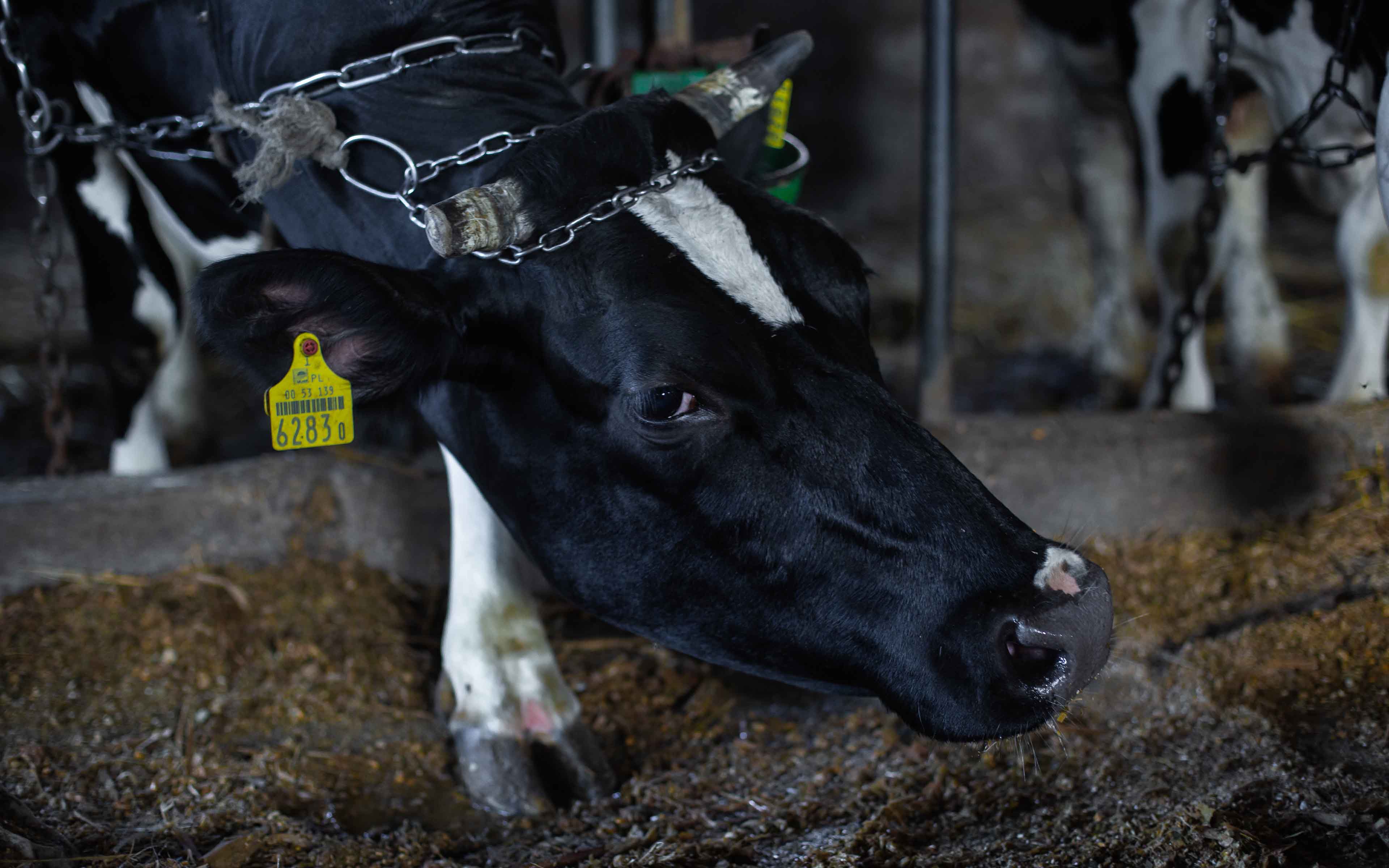
What Is Animal Welfare and Why Is It Important?
Though critics argue that advocating for animal welfare only cements animals’ exploitation in laboratories, on farms, and in other industrial situations, strengthening welfare standards makes these animals' lives more bearable.
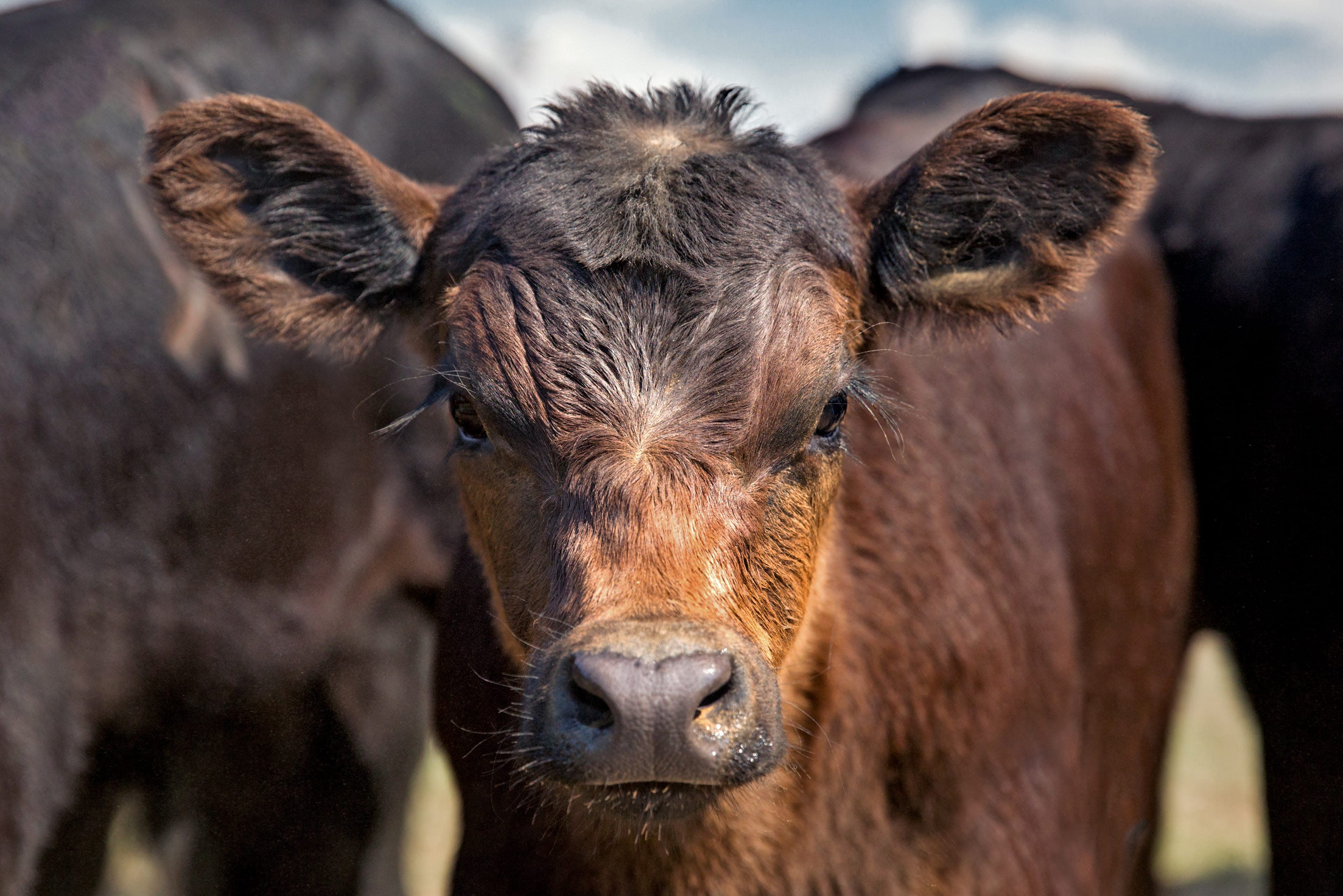
The Ethical Case for Welfare Reform
Industry welfare commitments are good for animals. Here’s why.

Law & Policy Policy
Resources for Journalists
- Food & Farming Media Network
- How to Pitch Us
- Freelance Charter
- Work With Us
Sentient Media
- Environmental Policy
- Code of Ethics
- Testimonials
Animal Rights: The Simple Idea That Sparked a Movement
Animal rights is a revolutionary idea and social movement that requires humans to reexamine their relationship with animals, especially animals used for food.
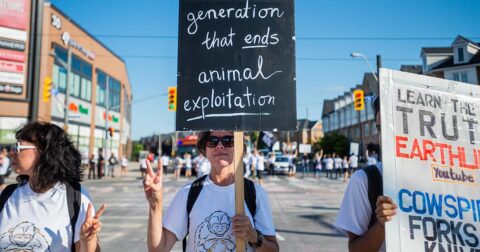
Explainer • Policy • Reflections
Words by Hemi Kim
There are many awkward conversations you might have at family or work meetings as the singular vegan . It’s possible to find yourself carefully describing your food choices, aware that you are on the edge of disassembling a joyous bulgogi dish into the painful experiences that were required to produce it. Talking about issues related to animal rights can be emotionally difficult especially when eating with and cooking for others is a love language; rejecting family and friends’ cooking can be hurtful.
Yet animal advocates have managed to tap into common, shared values, successfully encouraging more and more people to reexamine what living their values really looks like, especially values of respect, empathy, imagination, cooperation, adaptability, and compassion for all living beings.
Do Animals Have Rights?
In the United States, many animals are defined as property and do not have rights in the same sense that humans have rights. At least 13 nations have symbolically acknowledged the dignity and personhood of nonhuman animals or the need to show compassion towards them as something other than objects in their constitutions . (These are Brazil, Germany, India, Switzerland, Bulgaria, Cambodia, Egypt, the Iroquois Nations, Nepal, Papua New Guinea, the People’s Republic of China, the Slovak Republic, and Slovenia.) Yet such acknowledgments remain largely lip service—the animals in these thirteen nations are still treated similarly, both culturally and legally, to the animals in any other country.
Nevertheless, animal studies researchers such as Maneesha Deckha often see potential in the “shift in legal standing of nonhumans that constitutional recognition can precipitate.”
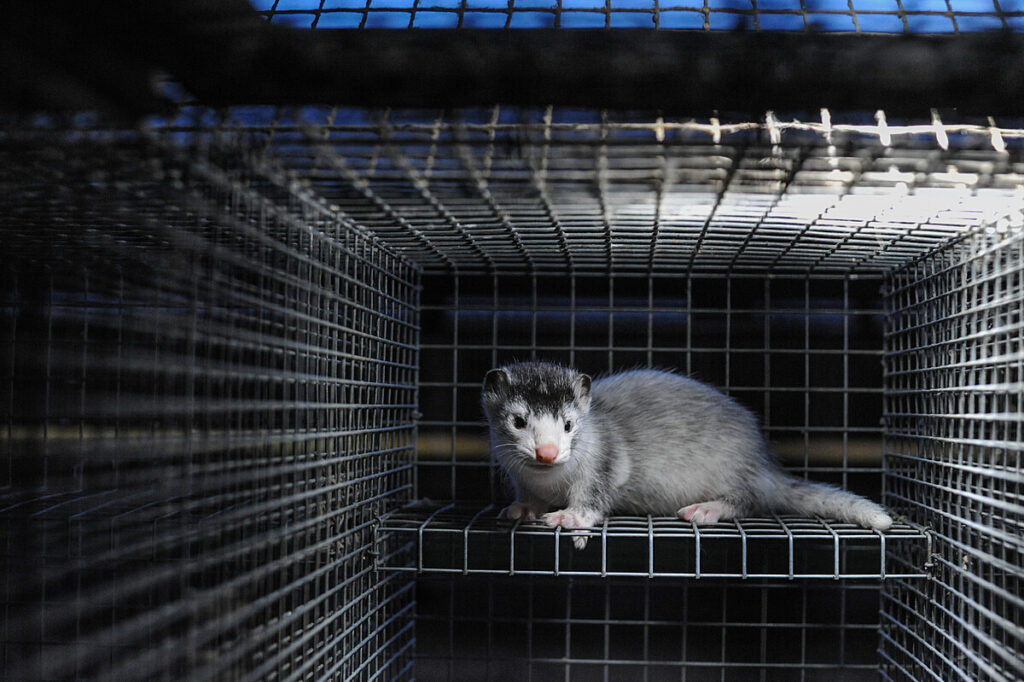
One advocacy approach seeks to translate the moral rights of animals into practical change by expanding how the law views animals: from property to personhood . Legal status as a person is something that U.S. courts have given to corporations, ships, and “entities of nature,” according to the Animal Legal Defense Fund , and it has been conferred on individual great apes outside the United States. Read more about the nuances of how advocates are trying to improve the status and legal protections of animals here .
What Are Animal Rights?
Animal rights form part of a way of thinking about nonhuman animals as off-limits for human exploitation. People that espouse this way of thinking try to direct their own and others’ behaviors away from eating, dressing, conducting scientific experiments, and being entertained in ways that involve harm to nonhuman animals.
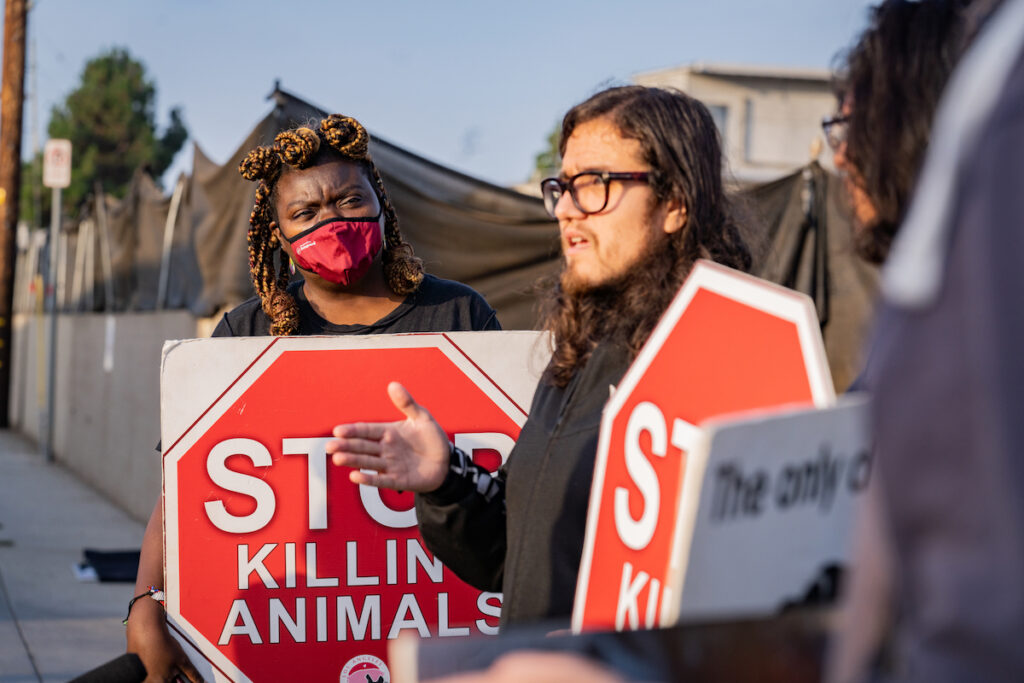
Animal rights is also a broad term describing animal advocacy , and the social movement focused on improving the lives of nonhuman animals. Yet the term “animal rights activist” can be alienating , which may be why groups prefer to use the terms “animal protection” or “animal advocates.”
When Did the Animal Rights Movement Begin in the U.S.?
The modern animal rights movement in the United States saw a major milestone in the 1970s with the publication of Peter Singer’s “Animal Liberation,” in which he argued that it was ethically important that nonhuman animals feel pain, and that this fact demanded far more equal treatment of nonhuman animals and humans. He also popularized the term “ speciesism ” to describe what happens when nonhuman animals are not given the same consideration as humans. Other thinkers, writers, and activist groups have also notably furthered and developed the fabric of the animal rights movement, both before and since Singer’s book, including Tom Regan and PETA.

Singer’s text itself reportedly sits on the shoulders of at least one British author who lived about a century prior. And for many centuries European travelers to India have learned about, and been attracted to, the concept of ahimsa and care for animals. Ahimsa , documented as early as the eighth century B.C. in Indian religious texts—Hindu, Jain, and Buddhist—affirms nonviolence and the alleviation of the suffering of all beings.
From the perspectives of scholars such as Cree writer Billy Ray Belcourt, and vegan theorists such as Aph and Syl Ko, the modern divide between animals and humans works in tandem with the imposition of white supremacy: on Indigenous people whose land was stolen by settler-colonists and who were targets of genocide, and on Black and Brown people who were and often continue to be treated as less than human.

Thus the animal protection movement in the United States is limited by the legacies and habits of thought of settler colonialism and other oppressions, and the history of the movement is whitewashed—something that people are now trying to undo. Belcourt, for example, argued in a 2020 article that people concerned with living ethically must challenge the white supremacy underpinning many efforts to expand the rights of nonhuman animals, and instead look to Indigenous traditions that see “animals as kin who co-produce a way of life that engenders care rather than and contra to suffering.”
What’s the Difference Between Animal Welfare and Animal Rights?
The terms “animal welfare” and “animal rights” are similar, but animal rights is a broader idea than animal welfare. Animal welfare refers to the responsibility of humans to treat nonhuman animals well and directly care for their health, but without challenging the overall circumstances that animals find themselves in or the ways they are used in society.
For example, an animal welfare advocate may be vigilant about how animals such as bears and apes are treated in the movie industry when they are working on a set. An animal rights proponent may instead call for an end to the use of animals in films altogether.
Another example of animal welfare is when people campaign for better treatment of young chickens before they are slaughtered. Though groups that campaign for animal welfare may also support goals that are compatible with animal rights, for example when promoting the consumption of plant-based foods.
What Are Some Examples of Animal Rights?
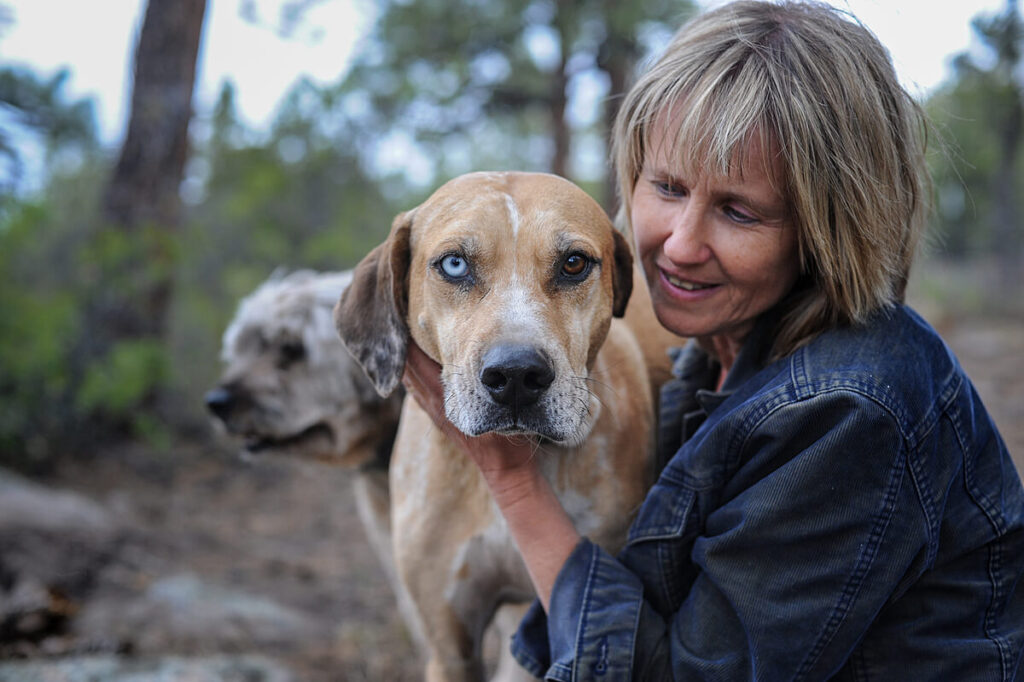
Animal rights supporters tend to be concerned that people use animals as a means to an end, typically without the animals’ assent to participate in an activity. In addition to the examples below, common areas of concern for animal rights include clothing, makeup, scientific experimentation, sports, and wildlife.
Animal Agriculture
Hogs are not just the source material for a good slow roast, crispy bacon, and pork belly. The pork industry also disassembles pigs for their parts to be used as ingredients in manufacturing, pharmaceuticals, and other scientific endeavors. People who support animal rights tend to oppose all farming of livestock and fish. The fictional film “Okja” is often cited as an animal rights story dealing with these issues—one that is sympathetic to animals sent to slaughter.
Entertainment
Circuses, zoos, and aquariums have been the subject of animal rights campaigns and popular documentaries, such as “Blackfish” , that have resulted in changes to how the entertainment industry markets animal-based entertainment.
Companionship and Working Animals
People concerned with animal rights might be more concerned with the potential for conscripting an animal into an unhealthy situation that exploits their labor than they would be about the benefits to humans of emotional support animals or land-mine-sniffing rats.
Animal Rights Arguments: Pros and Cons
The arguments of critics and supporters of animal protection can seem as diverse as the number of people who express an opinion. Below are some common reasons why people may feel pulled toward or away from animal rights causes.
Arguments in Favor of Animal Rights
In “Aphro-ism” , Syl and Aph Ko promote a view of animal rights within Black Veganism that sees animal rights as essential to ending racism. They write sensitively about the topic in a way that acknowledges how white supremacy has animalized Black people. They also draw a line from the oppression of nonhuman animals to white supremacy and convincingly argue that being antiracist is essential to animal liberation.
People allied with animal rights might also include Coast Salish activists in the Block Corporate Salmon campaign, who identify themselves as Salmon People and oppose the introduction of genetically modified fish to the local wildlife environment.
Arguments Against Animal Rights
People who oppose animal rights might see animals as property, and inferior to humans. They might argue that eating meat is a natural feature of the food chain, or that nonhuman animals exist for the benefit of humans .
Sometimes, deciding to disregard animal rights is a matter of practicality. For example, using life-saving products that were created with scientific research that relied on experimentation on nonhuman animals, as is the case with vaccines and pharmaceutical medicines.
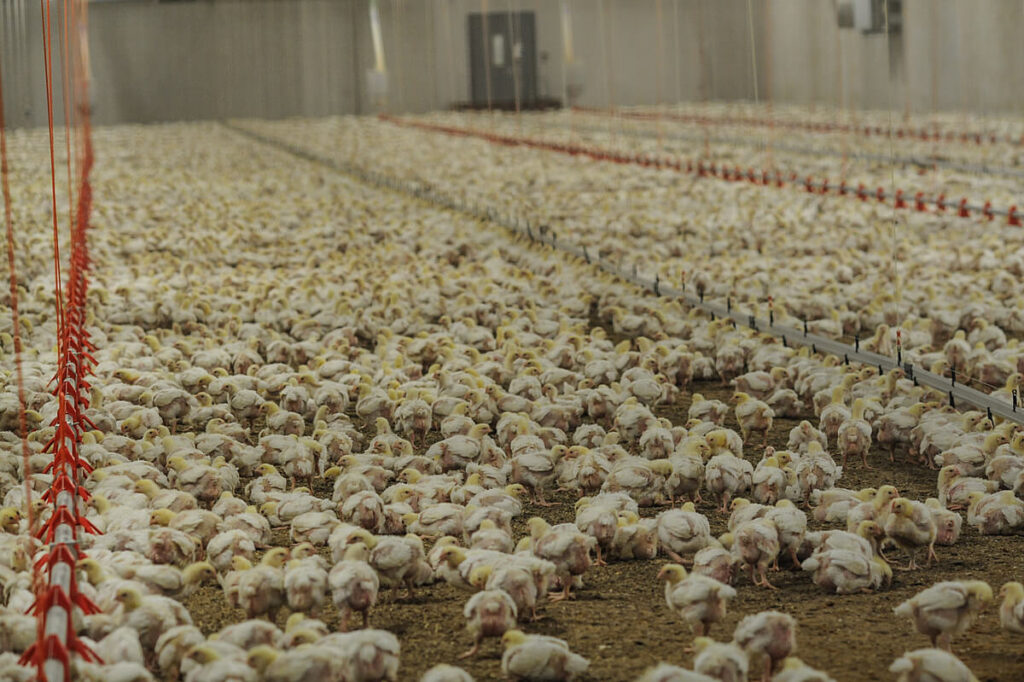
As animal advocate, Christopher Soul Eubanks wrote in March 2021, “To Black people and non-vegans of all races, the animal rights movement can appear as an affluent far-left group who ignore the systemic oppression they have benefited from while using that affluence to advocate for nonhumans.” Indeed, roughly 9 out of 10 people working for farmed animal protection organizations are white. In a more racially equitable world, that number would be closer to 6 in the United States.
Colonialist harms brought about by animal rights and vegan activism can be investigated: it’s something people of the global majority and others have begun.
Why Are Animal Rights Important?
“Being labeled less-than-human” is a condition that most people experience, one that Black and other oppressed peoples live daily, according to Aph Ko in a chapter of “Aphro-Ism.” Ko also writes in a later chapter that “‘[a]nimal’ is a category that we shove certain bodies into when we want to justify violence against them, which is why animal liberation should concern all who are minoritized, because at any moment you can become an ‘animal’ and be considered disposable.”
For Ko, being a critical thinker is more important than believing popular, yet false, narratives about oneself and nonhuman animals. This desire to re-evaluate what one thinks is a launching point for Afrofuturist possibilities, or Black-centered creativity , a philosophical wellspring for Black veganism. You can read more about Black veganism here , here , and here .

Animal rights, then, is an opportunity to constantly ask tough questions. And asking questions creates spaces within which vulnerable communities can flourish. For antiracist humane educator Dana McPhall , the following questions guide her work:
“So what would it look like to imagine a world where I’m not defined by the racial and gender constructs imposed upon me? Where people racialized as white are no longer invested in whiteness? Where the lives of nonhuman animals are no longer circumscribed within the social construct “animal?” Where huge swaths of our planet are not considered disposable, along with the people and wildlife who inhabit them?”
What Are the Consequences of Animal Rights?
Results of animal rights activism include the increasing popularity of vegan food products, a ban on selling fur in California, and state bans on using most animals in circuses. Keeping up with Sentient Media is one way to see these types of stories as they proliferate.
Ending Suffering Wherever It Persists
Nonhuman animals’ rights are not so much a question of legality or illegality, especially as laws tend to treat them as property. They are rather a way of thinking about what is morally right in a given cultural context. Avoiding the suffering of animals and respecting their right to exist are basic tenets of animal protection. As a way of thinking and being in community with others, animal rights can be an invitation for learning and imagining. Animal advocates of all races can dismantle white supremacy and undo “isms” by re-centering the experiences of Black, Brown, Indigenous, Asian, and other previously “less-than-human” people.
Independent Journalism Needs You
Hemi is a writer and educator.
When Marine Parks Close, Whales and Dolphins Face Uncertain Future
Entertainment • 7 min read
More Law & Policy
Beagles Are Bred by the Thousands on Factory Farms, and It’s Perfectly Legal
Justice • 4 min read
New Supreme Court Case Threatens Legal Protections for Animals
Ending the Chevron doctrine could be devastating for farm animals and wildlife.
Law & Policy • 7 min read
‘The Smell of Money’ Film Is Bringing Together Environmental and Food Justice Advocates
A new documentary chronicles the damage hog farm pollution has caused communities of Eastern North Carolina.
Justice • 5 min read
What Is Climate Change and How Do We Solve It?
Climate • 10 min read
Investigation
On Organic Caviar Farms, Fish Still Suffer
Aquaculture • 4 min read
Bird Flu Has Spread to Dairy Cows in Five States
Health • 4 min read
The 11 Most Helpful Animals on Earth (Though It’s Quite a Competition)
Research • 10 min read
Most Read Today
University of Notre Dame
Notre Dame Philosophical Reviews
- Home ›
- Reviews ›
The Moral Rights of Animals

Mylan Engel Jr. and Gary Lynn Comstock (eds.), The Moral Rights of Animals , Lexington, 2016, 296pp., $100.00 (hbk), ISBN 9781498531900.
Reviewed by Dan Hooley, University of Toronto
The attitudes of philosophers on our obligations to other animals and the view that other animals possess certain moral rights have shifted considerably in the last 40 years and a great deal of credit for this shift is owed to Tom Regan's The Case for Animal Rights and subsequent work. This excellent anthology grew out of a 2011 workshop held in Regan's honor and is dedicated to him. It features fourteen essays all of which intersect with Regan's views in some way. The authors largely defend the view that other animals have moral rights and those who don't hold that we have significant obligations to other animals. The essays succeed at exploring, critiquing, and expanding upon Regan's work in a way that is both rigorous and detailed, while accessible to those new to Regan or the animal rights literature.
The book has three parts. Part 1 focuses on the theoretical basis of animal rights, and responses to objections to animal rights. Part 2 looks at questions relating to the comparative value of human and nonhuman lives, with a focus on the comparative harm of death for humans and animals and the question of whether or not humans and animals have an equal right to life. Part 3 turns to the practical import of animal rights.
Part 1 begins with an essay by Regan, which succinctly summarizes the argument he made in The Case for Animal Rights that all individuals who are "subjects of a life" -- conscious, sentient individuals with an experiential welfare who have beliefs and desires and some awareness of the past and future -- have certain basic moral rights. This essay, combined with the relevant summaries in subsequent chapters, provide a sufficient overview of Regan's views, so those who have not read Regan before will not be lost.
In Chapter 2, Jeremy Garrett argues that deontological libertarians should accept animal rights. Garrett argues that libertarian views harmonize quite nicely with Regan's defense of animal rights and defends this view against objections from Nozick. In Chapter 3, Mylan Engel Jr. makes a straightforward and compelling case that if all humans have moral rights, then many other animals do as well since these animals have the properties that confer rights on humans. Engel also argues that most of the harmful uses of animals are wrong even if animals do not possess rights. In Chapter 4, Nathan Nobis considers some of the limitations of Regan's response to Carl Cohen's well-known "kind" argument, which holds that since animals are not of the kind of beings who are moral agents, they do not possess rights, and develops stronger objections to Cohen's position. In Chapter 5, Anne Baril argues that the equal inherent value of all animals does not demand intervention to prevent predation among wild animals. She argues that respect for wild animals, as the kinds of beings they are, does not require intervention to prevent predation.
Central or important to many of the essays in Part 1 is the much discussed (and poorly named) "Argument from Marginal Cases." [1] Versions and variations on this argument are put forward here by Regan, Garrett, Engel, and Nobis. Engel and Nobis, in particular, do a superb job challenging many of the common attempts to defend the view that all humans possess certain basic rights but all nonhumans do not. These essays present important challenges to those who think some form of human exceptionalism is defensible.
One important point made by Engel is that defenders of human exceptionalism must provide a plausible rationale for why any specific capacity, claimed to be both necessary and sufficient for the possession of a given right, is connected to that specific right in question. Many attempts to do this fail the test of having a plausible rationale. Moral autonomy is relevant to whether or not beings can be held morally accountable for their behavior, but it is far from clear why being morally autonomous is a necessary condition for possessing a right not to be harmed. This is because being morally autonomous is not necessary to have a morally relevant interest in not being harmed. As Engel notes, it is a much more plausible rationale to think that sentience is the morally relevant rights-conferring property for the right not to be harmed. This capacity has a much more plausible connection to the specific right in question.
A similar point is made by Nobis in response to Cohen's "kind" argument. Cohen claims all humans (regardless of cognitive capacities) have moral rights because they are members of a kind of being that possess moral agency. But this lacks a plausible rationale when it comes to the specific rights of non-rational humans (such as babies or individuals with severe cognitive disabilities). Cohen claims these individuals have rights related to autonomy because they are members of a kind that is morally autonomous. But even if we concede this, it would be wrong to let them make all the decisions about their lives that we allow paradigmatic adults to make (75). They seem to lack these rights because they do not possess the relevant interests. Once we recognize this, however, it is not clear why membership in a kind is morally relevant: we can be classified in different groups, but we don't always have the rights typical members of those groups possess.
Part 2 focuses primarily on the comparative harm of death for humans and animals and the question of whether or not humans and other animals have an equal right to life. In Chapter 6, Aaron Simmons argues that while life has less value for animals than for humans, they nevertheless possess an equal right to life, such that the negative rights they possess are just as stringent as those possessed by humans. In Chapter 7, Molly Gardner argues that Regan's rights view does not, as he claims, actually prohibit animal research in all cases. She develops an alternative position, what she calls the "attenuated rights view," that balances rights with a somewhat complex but interesting weighing principle. This view generates a strong presumption against animal research, but would not justify a categorical opposition to all harmful research involving animals. In Chapter 8, Evelyn Pluhar draws on ethological research to argue that all vertebrates and some cephalopod invertebrates should be seen as subjects of a life. She defends the view that all subjects of a life, who have satisfying lives and opportunities for future satisfaction, are harmed equally by death. In Chapter 9, Alastair Norcross argues that Singer's account of moral considerability -- where all sentient creatures deserve equal consideration -- can be combined with Regan's account of subjects of a life. Norcross argues that all sentient creatures deserve equal consideration, but that subjects of a life have a lot more to lose by dying than "merely" sentient beings. And in Chapter 10, Gary Comstock gives empirical evidence that suggests much of the time human behavior is controlled by non-conscious mechanisms. Comstock uses this to argue against the view that the ability of humans to control their behavior is a morally relevant difference separating humans from other animals: if animals act "on instinct" much of the time, so do we.
The question of whether or not humans are harmed more by death than animals and the related question of whether or not humans and animals have an equal right to life are some of the most difficult and perplexing questions in animal ethics. One notable feature of the essays in Part 2 is the diversity of views presented on these issues, despite the (mostly) shared belief that nonhuman animals possess basic moral rights.
Both Simmons and Gardner, for example, defend the common position that life has more value for (most) humans compared to most other animals because of our more sophisticated cognitive abilities. Simmons defends this by arguing that our more sophisticated cognitive capacities allow us to experience more creative and intellectual pleasures that are quantitatively and qualitatively superior to other pleasures (110).
One important objection not considered by either author concerns the ways in which the more sophisticated capacities of humans might allow for qualitatively and quantitatively worse forms of displeasure or negative experiences. If human life has more value because of the quantity and types of pleasures and valuable experiences we can enjoy, why are the distinct types of suffering, anxiety, and agony we can experience not relevant? If the claim is that humans have more valuable lives because of the net quantity and quality of pleasure and valuable experiences we can enjoy, then it isn't obviously true that humans have more valuable lives compared to animals, once we take the distinct types of displeasure we can experience into account. Further, even if it is true that some human lives contain more net value than other animals, this is likely not true for all of us.
More interesting, I think, is Simmons' suggestion that even if most humans are harmed more by death than most animals, this does not undermine an equal right to life. The assumption needed to ground this claim holds that two beings have an equal right to life only if the value of life for them is equal (112). But Simmons thinks we ought to reject this assumption because it entails that all humans do not have an equal right to life. Not only would this be the case for humans with severe cognitive disabilities but, Simmons rightly notes, there are reasons to think that among paradigmatic adult humans some are harmed more by death, as "some normal, adult humans seem to have greater capacities for reflective, creative, and intellectual activity than others" (112). This is an important point often ignored in this debate. Instead, Simmons suggests that to have an equal right to life only requires that the value of life for a being meets a certain threshold of value. And this threshold, he argues, should be set to include all individuals who are subjects of a life.
Norcross takes a different approach to these questions. He draws attention to an important element related to the harm of death not addressed in the other essays: the psychological relationship between an individual and her self in the future. Norcross argues that death is worse for animals who are subjects of a life (and who have some degree of self-consciousness) because of our psychological connection to our future selves: a fact we see when you must decide between a procedure that would extend your life for two years, or one that would extend "your" life by twenty years but sever all psychological connections between your present self and the future individual. Since it is rational to prefer the first procedure, Norcross argues that what is significant about death to individuals with a personal identity over time is the effect on their well-being (as opposed to the well-being of the organism) (171).
Subjects of a life, as beings with some degree of self-consciousness, have lives that matter to them . In this respect, their death is quite different from beings who are merely sentient and lack any psychological connection to their future selves. Their death may affect the net amount of well-being in the world, but it lacks personal significance to that being, in the same way that opting for the second procedure in the example above lacks any personal significance for me. This fact, Norcross argues, can ground a preference for subjects of a life over the merely sentient when it comes to issues of life and death (174).
Part 3 turns to more practical implications of animal rights and contains a variety of interesting and unique essays. In Chapter 11, Ramona Ilea argues that the capabilities approach to animals, articulated by Nussbaum, provides a useful and rigorous way to practically apply Regan's account of animal rights to questions of public policy and the law. In Chapter 13, Robert Bass develops an argument for veganism centered on moral caution. Bass argues that if there is a reasonable chance that an action is seriously wrong and no chance that it is morally required, then we ought to avoid that action. Bass thinks meat eating meets these criteria, and presents an array of arguments that attempt to show that the more modest conclusion is that there is a substantial chance meat-eating is wrong. In Chapter 14, Jason Hanna responds to arguments that animal rights views are consistent with "therapeutic hunting" aimed at reducing the suffering and future death of overabundant species. Hanna contends that hunters and wildlife managers are not in a situation where they must override an individual's rights, and that this blunts attempts to defend therapeutic hunting.
In Chapter 12, Scott Wilson argues that many who have made moral arguments for vegetarianism have failed to appreciate the significant interest meat-eaters have in consuming meat. He makes a strong case that the interest in consuming meat cannot be reduced to an interest simply in taste or nutrition, but instead reflects and involve a much wider variety of interests, including our self-conceptions of who we are, relationships with family and friends, convenience, and a variety of symbolic meanings. Wilson contends that this ultimately undermines utilitarian arguments for vegetarianism, and shows that rights-based approaches to animals are superior.
While I think Wilson is right to highlight some of the ways in which the consumption of meat reflects more than a simple interest in taste or pleasure, it is not clear his argument actually undermines a utilitarian argument for vegetarianism. Two points can be made in response to his argument. The first concerns the plasticity of our desires. We might think, against Wilson, that many meat-eaters overestimate the effect that switching to a vegetarian lifestyle will have on their welfare. If this is the case, it is not clear that any loss they might experience is as significant as they might initially be inclined to think (many vegetarians and vegans, for example, report enjoying food just as much or nearly as much as during their omnivorous days). Second, and related to this, there is a considerable body of evidence that suggests eating a plant-based diet makes it much more likely an individual will be healthier, avoid chronic diseases, and live longer. If this is the case, individuals who adopt a vegetarian diet may experience welfare gains (even if they miss eating meat), and even if they don't appreciate this fact.
This book offers an interesting and expansive exploration of current thought on animal rights. One downside it has, however, is that none of the essays engage with more recent work on the political status of non-human animals and their place in our legal and political institutions (Ilea's essay is in this ballpark, but it doesn't address any of the recent work on the topic). This omission is understandable: the anthology grew out of a 2011 conference, and much of the emerging literature on the political status of nonhuman animals was sparked by Sue Donaldson and Will Kymlicka's (2011) Zoopolis . However, one of the volume's stated goals is to "reflect the current state of philosophical thought on the moral rights of animals" (x). The political turn that is happening in animal ethics (and among animal rights theorists) can be understood as a potential implication of the moral rights of animals (and would thus fit in Part 3). This omission leaves out a rather exciting current development in the field that is particularly relevant to advocates of the moral rights of animals.
Some of this new work, moreover, would connect the topics in Parts 2 and 3 in an interesting way. One question we might have concerns whether much hangs on questions about the comparative harm of death or claims to an equal right to life. If other animals are significantly harmed by death and have a right to life, then we might think this is all we need to see that harmful animal-use industries, like animal agriculture, must be stopped, even if humans are harmed more by death or possess a more stringent right to life.
However, if we frame our relationship to other animals in political terms, the question of the comparative harm of death may take on a new importance. If, to give just one example, we begin to look at other domesticated animals as fellow members of our political communities, then there might be additional reasons why it matters how much death harms these beings. Domesticated animals could have positive rights to things like health care, emergency services, research and development into present diseases, and the policing and investigation of crimes. How we think about these claims and their comparative strength may depend, in part, on how we think about the comparative harm of death, and whether or not humans and animals have an equal right to life. I highlight this not to fault the book for this omission, but to note how some of the more recent developments in animal ethics connect with some of the topics explored in the essays, and potentially make these questions more urgent and intriguing.
Overall, this anthology makes an excellent companion to the work of Regan, and contains a great collection of readings on current debates in the area of animal rights. It would work quite well in a class on animal ethics, and the material is suitable and accessible for undergraduates of all levels.
[1] One problem with this name is that it is misleading. The cognitive diversity that is characteristic of humans is not something that just affects those with cognitive disabilities or dementia, but all of us across our lives (when we are young, during periods of severe illness, and for many of us, as we age).

TED is supported by ads and partners 00:00
A modern argument for the rights of animals
- social change
- TED Membership
- Search Menu
- Browse content in Arts and Humanities
- Browse content in Archaeology
- Anglo-Saxon and Medieval Archaeology
- Archaeological Methodology and Techniques
- Archaeology by Region
- Archaeology of Religion
- Archaeology of Trade and Exchange
- Biblical Archaeology
- Contemporary and Public Archaeology
- Environmental Archaeology
- Historical Archaeology
- History and Theory of Archaeology
- Industrial Archaeology
- Landscape Archaeology
- Mortuary Archaeology
- Prehistoric Archaeology
- Underwater Archaeology
- Urban Archaeology
- Zooarchaeology
- Browse content in Architecture
- Architectural Structure and Design
- History of Architecture
- Residential and Domestic Buildings
- Theory of Architecture
- Browse content in Art
- Art Subjects and Themes
- History of Art
- Industrial and Commercial Art
- Theory of Art
- Biographical Studies
- Byzantine Studies
- Browse content in Classical Studies
- Classical History
- Classical Philosophy
- Classical Mythology
- Classical Literature
- Classical Reception
- Classical Art and Architecture
- Classical Oratory and Rhetoric
- Greek and Roman Epigraphy
- Greek and Roman Law
- Greek and Roman Archaeology
- Greek and Roman Papyrology
- Late Antiquity
- Religion in the Ancient World
- Digital Humanities
- Browse content in History
- Colonialism and Imperialism
- Diplomatic History
- Environmental History
- Genealogy, Heraldry, Names, and Honours
- Genocide and Ethnic Cleansing
- Historical Geography
- History by Period
- History of Agriculture
- History of Education
- History of Emotions
- History of Gender and Sexuality
- Industrial History
- Intellectual History
- International History
- Labour History
- Legal and Constitutional History
- Local and Family History
- Maritime History
- Military History
- National Liberation and Post-Colonialism
- Oral History
- Political History
- Public History
- Regional and National History
- Revolutions and Rebellions
- Slavery and Abolition of Slavery
- Social and Cultural History
- Theory, Methods, and Historiography
- Urban History
- World History
- Browse content in Language Teaching and Learning
- Language Learning (Specific Skills)
- Language Teaching Theory and Methods
- Browse content in Linguistics
- Applied Linguistics
- Cognitive Linguistics
- Computational Linguistics
- Forensic Linguistics
- Grammar, Syntax and Morphology
- Historical and Diachronic Linguistics
- History of English
- Language Acquisition
- Language Variation
- Language Families
- Language Evolution
- Language Reference
- Lexicography
- Linguistic Theories
- Linguistic Typology
- Linguistic Anthropology
- Phonetics and Phonology
- Psycholinguistics
- Sociolinguistics
- Translation and Interpretation
- Writing Systems
- Browse content in Literature
- Bibliography
- Children's Literature Studies
- Literary Studies (Asian)
- Literary Studies (European)
- Literary Studies (Eco-criticism)
- Literary Studies (Modernism)
- Literary Studies (Romanticism)
- Literary Studies (American)
- Literary Studies - World
- Literary Studies (1500 to 1800)
- Literary Studies (19th Century)
- Literary Studies (20th Century onwards)
- Literary Studies (African American Literature)
- Literary Studies (British and Irish)
- Literary Studies (Early and Medieval)
- Literary Studies (Fiction, Novelists, and Prose Writers)
- Literary Studies (Gender Studies)
- Literary Studies (Graphic Novels)
- Literary Studies (History of the Book)
- Literary Studies (Plays and Playwrights)
- Literary Studies (Poetry and Poets)
- Literary Studies (Postcolonial Literature)
- Literary Studies (Queer Studies)
- Literary Studies (Science Fiction)
- Literary Studies (Travel Literature)
- Literary Studies (War Literature)
- Literary Studies (Women's Writing)
- Literary Theory and Cultural Studies
- Mythology and Folklore
- Shakespeare Studies and Criticism
- Browse content in Media Studies
- Browse content in Music
- Applied Music
- Dance and Music
- Ethics in Music
- Ethnomusicology
- Gender and Sexuality in Music
- Medicine and Music
- Music Cultures
- Music and Religion
- Music and Culture
- Music and Media
- Music Education and Pedagogy
- Music Theory and Analysis
- Musical Scores, Lyrics, and Libretti
- Musical Structures, Styles, and Techniques
- Musicology and Music History
- Performance Practice and Studies
- Race and Ethnicity in Music
- Sound Studies
- Browse content in Performing Arts
- Browse content in Philosophy
- Aesthetics and Philosophy of Art
- Epistemology
- Feminist Philosophy
- History of Western Philosophy
- Metaphysics
- Moral Philosophy
- Non-Western Philosophy
- Philosophy of Science
- Philosophy of Action
- Philosophy of Law
- Philosophy of Religion
- Philosophy of Language
- Philosophy of Mind
- Philosophy of Perception
- Philosophy of Mathematics and Logic
- Practical Ethics
- Social and Political Philosophy
- Browse content in Religion
- Biblical Studies
- Christianity
- East Asian Religions
- History of Religion
- Judaism and Jewish Studies
- Qumran Studies
- Religion and Education
- Religion and Health
- Religion and Politics
- Religion and Science
- Religion and Law
- Religion and Art, Literature, and Music
- Religious Studies
- Browse content in Society and Culture
- Cookery, Food, and Drink
- Cultural Studies
- Customs and Traditions
- Ethical Issues and Debates
- Hobbies, Games, Arts and Crafts
- Lifestyle, Home, and Garden
- Natural world, Country Life, and Pets
- Popular Beliefs and Controversial Knowledge
- Sports and Outdoor Recreation
- Technology and Society
- Travel and Holiday
- Visual Culture
- Browse content in Law
- Arbitration
- Browse content in Company and Commercial Law
- Commercial Law
- Company Law
- Browse content in Comparative Law
- Systems of Law
- Competition Law
- Browse content in Constitutional and Administrative Law
- Government Powers
- Judicial Review
- Local Government Law
- Military and Defence Law
- Parliamentary and Legislative Practice
- Construction Law
- Contract Law
- Browse content in Criminal Law
- Criminal Procedure
- Criminal Evidence Law
- Sentencing and Punishment
- Employment and Labour Law
- Environment and Energy Law
- Browse content in Financial Law
- Banking Law
- Insolvency Law
- History of Law
- Human Rights and Immigration
- Intellectual Property Law
- Browse content in International Law
- Private International Law and Conflict of Laws
- Public International Law
- IT and Communications Law
- Jurisprudence and Philosophy of Law
- Law and Politics
- Law and Society
- Browse content in Legal System and Practice
- Courts and Procedure
- Legal Skills and Practice
- Primary Sources of Law
- Regulation of Legal Profession
- Medical and Healthcare Law
- Browse content in Policing
- Criminal Investigation and Detection
- Police and Security Services
- Police Procedure and Law
- Police Regional Planning
- Browse content in Property Law
- Personal Property Law
- Study and Revision
- Terrorism and National Security Law
- Browse content in Trusts Law
- Wills and Probate or Succession
- Browse content in Medicine and Health
- Browse content in Allied Health Professions
- Arts Therapies
- Clinical Science
- Dietetics and Nutrition
- Occupational Therapy
- Operating Department Practice
- Physiotherapy
- Radiography
- Speech and Language Therapy
- Browse content in Anaesthetics
- General Anaesthesia
- Neuroanaesthesia
- Browse content in Clinical Medicine
- Acute Medicine
- Cardiovascular Medicine
- Clinical Genetics
- Clinical Pharmacology and Therapeutics
- Dermatology
- Endocrinology and Diabetes
- Gastroenterology
- Genito-urinary Medicine
- Geriatric Medicine
- Infectious Diseases
- Medical Oncology
- Medical Toxicology
- Pain Medicine
- Palliative Medicine
- Rehabilitation Medicine
- Respiratory Medicine and Pulmonology
- Rheumatology
- Sleep Medicine
- Sports and Exercise Medicine
- Clinical Neuroscience
- Community Medical Services
- Critical Care
- Emergency Medicine
- Forensic Medicine
- Haematology
- History of Medicine
- Browse content in Medical Dentistry
- Oral and Maxillofacial Surgery
- Paediatric Dentistry
- Restorative Dentistry and Orthodontics
- Surgical Dentistry
- Medical Ethics
- Browse content in Medical Skills
- Clinical Skills
- Communication Skills
- Nursing Skills
- Surgical Skills
- Medical Statistics and Methodology
- Browse content in Neurology
- Clinical Neurophysiology
- Neuropathology
- Nursing Studies
- Browse content in Obstetrics and Gynaecology
- Gynaecology
- Occupational Medicine
- Ophthalmology
- Otolaryngology (ENT)
- Browse content in Paediatrics
- Neonatology
- Browse content in Pathology
- Chemical Pathology
- Clinical Cytogenetics and Molecular Genetics
- Histopathology
- Medical Microbiology and Virology
- Patient Education and Information
- Browse content in Pharmacology
- Psychopharmacology
- Browse content in Popular Health
- Caring for Others
- Complementary and Alternative Medicine
- Self-help and Personal Development
- Browse content in Preclinical Medicine
- Cell Biology
- Molecular Biology and Genetics
- Reproduction, Growth and Development
- Primary Care
- Professional Development in Medicine
- Browse content in Psychiatry
- Addiction Medicine
- Child and Adolescent Psychiatry
- Forensic Psychiatry
- Learning Disabilities
- Old Age Psychiatry
- Psychotherapy
- Browse content in Public Health and Epidemiology
- Epidemiology
- Public Health
- Browse content in Radiology
- Clinical Radiology
- Interventional Radiology
- Nuclear Medicine
- Radiation Oncology
- Reproductive Medicine
- Browse content in Surgery
- Cardiothoracic Surgery
- Gastro-intestinal and Colorectal Surgery
- General Surgery
- Neurosurgery
- Paediatric Surgery
- Peri-operative Care
- Plastic and Reconstructive Surgery
- Surgical Oncology
- Transplant Surgery
- Trauma and Orthopaedic Surgery
- Vascular Surgery
- Browse content in Science and Mathematics
- Browse content in Biological Sciences
- Aquatic Biology
- Biochemistry
- Bioinformatics and Computational Biology
- Developmental Biology
- Ecology and Conservation
- Evolutionary Biology
- Genetics and Genomics
- Microbiology
- Molecular and Cell Biology
- Natural History
- Plant Sciences and Forestry
- Research Methods in Life Sciences
- Structural Biology
- Systems Biology
- Zoology and Animal Sciences
- Browse content in Chemistry
- Analytical Chemistry
- Computational Chemistry
- Crystallography
- Environmental Chemistry
- Industrial Chemistry
- Inorganic Chemistry
- Materials Chemistry
- Medicinal Chemistry
- Mineralogy and Gems
- Organic Chemistry
- Physical Chemistry
- Polymer Chemistry
- Study and Communication Skills in Chemistry
- Theoretical Chemistry
- Browse content in Computer Science
- Artificial Intelligence
- Computer Architecture and Logic Design
- Game Studies
- Human-Computer Interaction
- Mathematical Theory of Computation
- Programming Languages
- Software Engineering
- Systems Analysis and Design
- Virtual Reality
- Browse content in Computing
- Business Applications
- Computer Security
- Computer Games
- Computer Networking and Communications
- Digital Lifestyle
- Graphical and Digital Media Applications
- Operating Systems
- Browse content in Earth Sciences and Geography
- Atmospheric Sciences
- Environmental Geography
- Geology and the Lithosphere
- Maps and Map-making
- Meteorology and Climatology
- Oceanography and Hydrology
- Palaeontology
- Physical Geography and Topography
- Regional Geography
- Soil Science
- Urban Geography
- Browse content in Engineering and Technology
- Agriculture and Farming
- Biological Engineering
- Civil Engineering, Surveying, and Building
- Electronics and Communications Engineering
- Energy Technology
- Engineering (General)
- Environmental Science, Engineering, and Technology
- History of Engineering and Technology
- Mechanical Engineering and Materials
- Technology of Industrial Chemistry
- Transport Technology and Trades
- Browse content in Environmental Science
- Applied Ecology (Environmental Science)
- Conservation of the Environment (Environmental Science)
- Environmental Sustainability
- Environmentalist Thought and Ideology (Environmental Science)
- Management of Land and Natural Resources (Environmental Science)
- Natural Disasters (Environmental Science)
- Nuclear Issues (Environmental Science)
- Pollution and Threats to the Environment (Environmental Science)
- Social Impact of Environmental Issues (Environmental Science)
- History of Science and Technology
- Browse content in Materials Science
- Ceramics and Glasses
- Composite Materials
- Metals, Alloying, and Corrosion
- Nanotechnology
- Browse content in Mathematics
- Applied Mathematics
- Biomathematics and Statistics
- History of Mathematics
- Mathematical Education
- Mathematical Finance
- Mathematical Analysis
- Numerical and Computational Mathematics
- Probability and Statistics
- Pure Mathematics
- Browse content in Neuroscience
- Cognition and Behavioural Neuroscience
- Development of the Nervous System
- Disorders of the Nervous System
- History of Neuroscience
- Invertebrate Neurobiology
- Molecular and Cellular Systems
- Neuroendocrinology and Autonomic Nervous System
- Neuroscientific Techniques
- Sensory and Motor Systems
- Browse content in Physics
- Astronomy and Astrophysics
- Atomic, Molecular, and Optical Physics
- Biological and Medical Physics
- Classical Mechanics
- Computational Physics
- Condensed Matter Physics
- Electromagnetism, Optics, and Acoustics
- History of Physics
- Mathematical and Statistical Physics
- Measurement Science
- Nuclear Physics
- Particles and Fields
- Plasma Physics
- Quantum Physics
- Relativity and Gravitation
- Semiconductor and Mesoscopic Physics
- Browse content in Psychology
- Affective Sciences
- Clinical Psychology
- Cognitive Neuroscience
- Cognitive Psychology
- Criminal and Forensic Psychology
- Developmental Psychology
- Educational Psychology
- Evolutionary Psychology
- Health Psychology
- History and Systems in Psychology
- Music Psychology
- Neuropsychology
- Organizational Psychology
- Psychological Assessment and Testing
- Psychology of Human-Technology Interaction
- Psychology Professional Development and Training
- Research Methods in Psychology
- Social Psychology
- Browse content in Social Sciences
- Browse content in Anthropology
- Anthropology of Religion
- Human Evolution
- Medical Anthropology
- Physical Anthropology
- Regional Anthropology
- Social and Cultural Anthropology
- Theory and Practice of Anthropology
- Browse content in Business and Management
- Business Strategy
- Business History
- Business Ethics
- Business and Government
- Business and Technology
- Business and the Environment
- Comparative Management
- Corporate Governance
- Corporate Social Responsibility
- Entrepreneurship
- Health Management
- Human Resource Management
- Industrial and Employment Relations
- Industry Studies
- Information and Communication Technologies
- International Business
- Knowledge Management
- Management and Management Techniques
- Operations Management
- Organizational Theory and Behaviour
- Pensions and Pension Management
- Public and Nonprofit Management
- Strategic Management
- Supply Chain Management
- Browse content in Criminology and Criminal Justice
- Criminal Justice
- Criminology
- Forms of Crime
- International and Comparative Criminology
- Youth Violence and Juvenile Justice
- Development Studies
- Browse content in Economics
- Agricultural, Environmental, and Natural Resource Economics
- Asian Economics
- Behavioural Finance
- Behavioural Economics and Neuroeconomics
- Econometrics and Mathematical Economics
- Economic Systems
- Economic Methodology
- Economic History
- Economic Development and Growth
- Financial Markets
- Financial Institutions and Services
- General Economics and Teaching
- Health, Education, and Welfare
- History of Economic Thought
- International Economics
- Labour and Demographic Economics
- Law and Economics
- Macroeconomics and Monetary Economics
- Microeconomics
- Public Economics
- Urban, Rural, and Regional Economics
- Welfare Economics
- Browse content in Education
- Adult Education and Continuous Learning
- Care and Counselling of Students
- Early Childhood and Elementary Education
- Educational Equipment and Technology
- Educational Strategies and Policy
- Higher and Further Education
- Organization and Management of Education
- Philosophy and Theory of Education
- Schools Studies
- Secondary Education
- Teaching of a Specific Subject
- Teaching of Specific Groups and Special Educational Needs
- Teaching Skills and Techniques
- Browse content in Environment
- Applied Ecology (Social Science)
- Climate Change
- Conservation of the Environment (Social Science)
- Environmentalist Thought and Ideology (Social Science)
- Natural Disasters (Environment)
- Social Impact of Environmental Issues (Social Science)
- Browse content in Human Geography
- Cultural Geography
- Economic Geography
- Political Geography
- Browse content in Interdisciplinary Studies
- Communication Studies
- Museums, Libraries, and Information Sciences
- Browse content in Politics
- African Politics
- Asian Politics
- Chinese Politics
- Comparative Politics
- Conflict Politics
- Elections and Electoral Studies
- Environmental Politics
- European Union
- Foreign Policy
- Gender and Politics
- Human Rights and Politics
- Indian Politics
- International Relations
- International Organization (Politics)
- International Political Economy
- Irish Politics
- Latin American Politics
- Middle Eastern Politics
- Political Methodology
- Political Communication
- Political Philosophy
- Political Sociology
- Political Theory
- Political Behaviour
- Political Economy
- Political Institutions
- Politics and Law
- Public Administration
- Public Policy
- Quantitative Political Methodology
- Regional Political Studies
- Russian Politics
- Security Studies
- State and Local Government
- UK Politics
- US Politics
- Browse content in Regional and Area Studies
- African Studies
- Asian Studies
- East Asian Studies
- Japanese Studies
- Latin American Studies
- Middle Eastern Studies
- Native American Studies
- Scottish Studies
- Browse content in Research and Information
- Research Methods
- Browse content in Social Work
- Addictions and Substance Misuse
- Adoption and Fostering
- Care of the Elderly
- Child and Adolescent Social Work
- Couple and Family Social Work
- Developmental and Physical Disabilities Social Work
- Direct Practice and Clinical Social Work
- Emergency Services
- Human Behaviour and the Social Environment
- International and Global Issues in Social Work
- Mental and Behavioural Health
- Social Justice and Human Rights
- Social Policy and Advocacy
- Social Work and Crime and Justice
- Social Work Macro Practice
- Social Work Practice Settings
- Social Work Research and Evidence-based Practice
- Welfare and Benefit Systems
- Browse content in Sociology
- Childhood Studies
- Community Development
- Comparative and Historical Sociology
- Economic Sociology
- Gender and Sexuality
- Gerontology and Ageing
- Health, Illness, and Medicine
- Marriage and the Family
- Migration Studies
- Occupations, Professions, and Work
- Organizations
- Population and Demography
- Race and Ethnicity
- Social Theory
- Social Movements and Social Change
- Social Research and Statistics
- Social Stratification, Inequality, and Mobility
- Sociology of Religion
- Sociology of Education
- Sport and Leisure
- Urban and Rural Studies
- Browse content in Warfare and Defence
- Defence Strategy, Planning, and Research
- Land Forces and Warfare
- Military Administration
- Military Life and Institutions
- Naval Forces and Warfare
- Other Warfare and Defence Issues
- Peace Studies and Conflict Resolution
- Weapons and Equipment

Animal Rights: A Very Short Introduction
Author webpage
- Cite Icon Cite
- Permissions Icon Permissions
Animal Rights: A Very Short Introduction explores the implications for how we should treat animals in connection with our diet, zoos, and research. Most people are opposed to cruelty and sense that animals have moral significance. At the same time, traditional views that sanction animal use with few constraints have heavily influenced beliefs and everyday practices. How should we understand the moral status of animals vis-à-vis human beings? Do animals have moral rights? If so, what does this mean? What kinds of beings are animals, what sorts of mental lives do they have, and how should we understand welfare?
Signed in as
Institutional accounts.
- GoogleCrawler [DO NOT DELETE]
- Google Scholar Indexing
Personal account
- Sign in with email/username & password
- Get email alerts
- Save searches
- Purchase content
- Activate your purchase/trial code
- Add your ORCID iD
Institutional access
Sign in with a library card.
- Sign in with username/password
- Recommend to your librarian
- Institutional account management
- Get help with access
Access to content on Oxford Academic is often provided through institutional subscriptions and purchases. If you are a member of an institution with an active account, you may be able to access content in one of the following ways:
IP based access
Typically, access is provided across an institutional network to a range of IP addresses. This authentication occurs automatically, and it is not possible to sign out of an IP authenticated account.
Sign in through your institution
Choose this option to get remote access when outside your institution. Shibboleth/Open Athens technology is used to provide single sign-on between your institution’s website and Oxford Academic.
- Click Sign in through your institution.
- Select your institution from the list provided, which will take you to your institution's website to sign in.
- When on the institution site, please use the credentials provided by your institution. Do not use an Oxford Academic personal account.
- Following successful sign in, you will be returned to Oxford Academic.
If your institution is not listed or you cannot sign in to your institution’s website, please contact your librarian or administrator.
Enter your library card number to sign in. If you cannot sign in, please contact your librarian.
Society Members
Society member access to a journal is achieved in one of the following ways:
Sign in through society site
Many societies offer single sign-on between the society website and Oxford Academic. If you see ‘Sign in through society site’ in the sign in pane within a journal:
- Click Sign in through society site.
- When on the society site, please use the credentials provided by that society. Do not use an Oxford Academic personal account.
If you do not have a society account or have forgotten your username or password, please contact your society.
Sign in using a personal account
Some societies use Oxford Academic personal accounts to provide access to their members. See below.
A personal account can be used to get email alerts, save searches, purchase content, and activate subscriptions.
Some societies use Oxford Academic personal accounts to provide access to their members.
Viewing your signed in accounts
Click the account icon in the top right to:
- View your signed in personal account and access account management features.
- View the institutional accounts that are providing access.
Signed in but can't access content
Oxford Academic is home to a wide variety of products. The institutional subscription may not cover the content that you are trying to access. If you believe you should have access to that content, please contact your librarian.
For librarians and administrators, your personal account also provides access to institutional account management. Here you will find options to view and activate subscriptions, manage institutional settings and access options, access usage statistics, and more.
Our books are available by subscription or purchase to libraries and institutions.
External resources
- In the OUP print catalogue
- Moral Status Obligations to Persons and Other Living Things (2000) on Oxford Scholarship Online
- The Animal Question (2002) on Oxford Scholarship Online
- "The Ethics of Confining Animals" in The Oxford Handbook of Animal Ethics (2011) on Oxford Handbooks Online
- About Oxford Academic
- Publish journals with us
- University press partners
- What we publish
- New features
- Open access
- Rights and permissions
- Accessibility
- Advertising
- Media enquiries
- Oxford University Press
- Oxford Languages
- University of Oxford
Oxford University Press is a department of the University of Oxford. It furthers the University's objective of excellence in research, scholarship, and education by publishing worldwide
- Copyright © 2024 Oxford University Press
- Cookie settings
- Cookie policy
- Privacy policy
- Legal notice
This Feature Is Available To Subscribers Only
Sign In or Create an Account
This PDF is available to Subscribers Only
For full access to this pdf, sign in to an existing account, or purchase an annual subscription.
Animal Rights Essay: Topics, Outline, & Writing Tips
- 🐇 Animal Rights Essay: the Basics
- 💡 Animal Rights Essay Topics
- 📑 Outlining Your Essay
- ✍️ Sample Essay (200 Words)
🔗 References
🐇 animal rights essay: what is it about.
Animal rights supporters advocate for the idea that animals should have the same freedom to live as they wish, just as humans do. They should not be exploited or used in meat , fur, and other production. At long last, we should distinguish animals from inanimate objects and resources like coal, timber, or oil.

Interdisciplinary research has shown that animals are emotional and sensitive, just like we are.
Their array of emotions includes joy, happiness, embarrassment, resentment, jealousy, anger, love, compassion, respect, disgust, despair, and even grief.
However, animal rights legislation does not extend human rights to animals. It establishes their right to have their fundamental needs and interests respected while people decide how to treat them. This right changes the status of animals from being property to being legal entities.
The statement may sound strange until we recall that churches , banks, and universities are also legal entities. Their interests are legally protected by law. Then why do we disregard the feelings of animals , which are not inanimate institutions? Several federal laws protect them from human interference.
But the following statements are only some of the rules that could one day protect animal rights in full:
- Animals should not be killed by hunting.
- Animals’ habitats should allow them to live in freedom.
- Animals should not be bred for sale or any other purpose.
- Animals should not be used for food by industries or households.
Most arguments against the adoption of similar laws are linked to money concerns. Animal exploitation has grown into a multi-billion-dollar industry. The lives of many private farmers depend on meat production, and most people prefer not to change the comfortable status quo.
Animal Rights Argumentative Essay
An animal rights argumentative essay should tackle a problematic issue that people have widely discussed. While choosing ideas for the assignment, opt for the most debatable topics.
Here is a brief list of argumentative essay prompts on animal rights:
- The pros and cons of animal rights.
- Can humanity exist without meat production?
- Do animals have souls?
- Should society become vegan to protect animal rights?
As you see, these questions could raise controversy between interlocutors. Your purpose is to take a side and give several arguments in its support. Then you’ll have to state a counterargument to your opinion and explain why it is incorrect.

Animal Rights Persuasive Essay
An animal rights persuasive essay should clearly state your opinion on the topic without analyzing different points of view. Still, the purpose of your article is to persuade the reader that your position is not only reasonable but the only correct one. For this purpose, select topics relating to your opinion or formulated in questionary form.
For example:
- What is your idea about wearing fur?
- Do you think people would ever ban animal exploitation ?
- Is having pets a harmful practice?
- Animal factories hinder the development of civilization .
💡 53 Animal Rights Essay Topics
- Animal rights have been suppressed for ages because people disregard their mental abilities .
- Cosmetic and medical animal testing .
- Laws preventing unnecessary suffering of animals mean that there is some necessary suffering.
- Red fluorescent protein transgenic dogs experiment .
- Do you believe animals should have legal rights?
- Genetically modified animals and implications .
- Why is animal welfare important?
- Neutering animals to prevent overpopulation: Pros and cons.
- Animal testing: Arguments for and against.
- What is our impact on marine life ?
- Some animals cannot stay wild .
- Animal testing for medical purposes .
- We are not the ones to choose which species to preserve.
- Pavlov’s dog experiment .
- Keeping dogs chained outdoors is animal neglect.
- The use of animals for research .
- Animal dissection as a learning tool: Alternatives?
- More people beat their pets than we think.
- Duties to non-human animals .
- If we do not control the population of some animals, they will control ours.
- Animals in entertainment: Not entertaining at all.
- Animals in research, education, and teaching.
- Which non-animal production endangers the species?
- Is animal testing really needed?
- Why do some people think that buying a new pet is cheaper than paying for medical treatment of the old one?
- Animal experiments: benefits, ethics, and defenders.
- Can people still be carnivorous if they stop eating animals?
- Animal testing role.
- Marine aquariums and zoos are animal prisons.
- Animal experimentation: justification arguments .
- What would happen if we replace animals in circuses with people, keeping the same living conditions?
- The ethics of animal use in scientific research .
- Animal sports: Relics of the past.
- Animal testing ban: counterargument and rebuttal .
- Denial to purchase animal-tested cosmetics will not change anything.
- Animal research, its ineffectiveness and amorality .
- Animal rights protection based on their intellect level: It tells a lot about humanity.
- Debates of using animals in scientific analysis .
- How can we ban tests on rats and kill them in our homes at the same time?
- Animal testing in experiments .
- What is the level of tissue engineering development in leather and meat production?
- Equal consideration of interests to non-human animals .
- Animals should not have to be our servants.
- Zoos as an example of humans’ immorality .
- We should feed wild animals to help them survive.
- Animal testing in biomedical research .
- Abolitionism: The right not to be owned.
- Do you support the Prima facie rights theory?
- Psychologist perspective on research involving animal and human subjects.
- Ecofeminism: What is the link between animals’ and women’s rights ?
- No philosophy could rationalize cruelty against animals.
- Qualities that humans and animals share .
- Ancient Buddhist societies and vegetarianism: A research paper.
Need more ideas? You are welcome to use our free research topic generator !
📑 Animal Rights Essay Outline
An animal rights essay should be constructed as a standard 5-paragraph essay (if not required otherwise in the assignment). The three following sections provide a comprehensive outline.
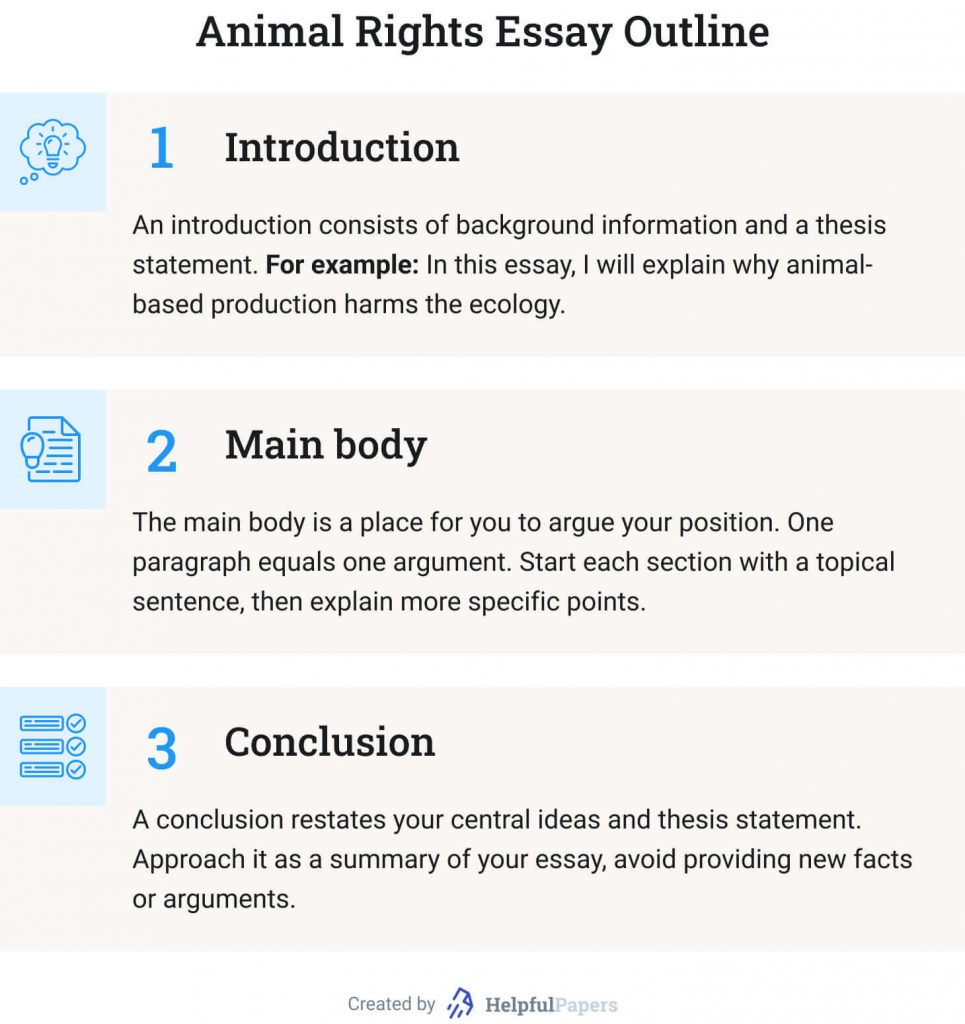
Animal Rights Essay: Introduction
An introduction consists of:
- Background information,
- A thesis statement .
In other words, here you need to explain why you decided to write about the given topic and which position you will take. The background part should comprise a couple of sentences highlighting the topicality of the issue. The thesis statement expresses your plans in the essay.
For example: In this essay, I will explain why animal-based production harms the ecology.
Animal Rights Essay: Main Body
The main body is a place for you to argue your position . One paragraph equals one argument. In informative essays, replace argumentation with facts.
Start each section with a topical sentence consisting of a general truth. Then give some explanation and more specific points. By the way, at the end of this article, you’ll find a bonus! It is a priceless selection of statistics and facts about animal rights.
Animal Rights Essay: Conclusion
A conclusion restates your central ideas and thesis statement. Approach it as a summary of your essay, avoid providing new facts or arguments.
✍️ Animal Rights Essay Example (200 Words)
Why is animal welfare important? The term “animal welfare” evokes the pictures of happy cows from a milk advertisement. But the reality has nothing to do with these bright videos. Humane treatment of animals is a relative concept. This essay explains why animal welfare is important, despite that it does not prevent farms from killing or confining animals.
The best way to approach animal welfare is by thinking of it as a temporary measure. We all agree that the current state of the economy does not allow humanity to abandon animal-based production. Moreover, such quick decisions could make farm animals suffer even more. But ensuring the minimum possible pain is the best solution as of the moment.
The current legislation on animal welfare is far from perfect. The Animal Welfare Act of 1966 prevents cruelty against animals in labs and zoos. Meanwhile, the majority of suffering animals do not fall under its purview. For example, it says nothing about the vivisection of rats and mice for educational and research purposes, although the procedure is extremely painful for the creature. Neither does it protect farm animals.
Unfortunately, the principles of animal welfare leave too much room for interpretation. Animals should be free from fear and stress, but how can we measure that? They should be allowed to engage in natural behaviors, but no confined space would let them do so. Thus, the legislation is imprecise.
The problem of animal welfare is almost unresolvable because it is a temporary measure to prevent any suffering of domesticated animals. It has its drawbacks but allows us to ensure at least some comfort for those we unjustifiably use for food. They have the same right to live on this planet as we do, and animal farming will be stopped one day.
📊 Bonus: Statistics & Facts for Your Animal Rights Essay Introduction
Improve the quality of your essay on animal rights by working in the following statistics and facts about animals.
- According to USDA, National Agricultural Statistics Service , about 4.6 billion animals — including hogs, sheep, cattle, chickens, ducks, lambs, and turkey — were killed and used for food in the United States last year (2015).
- People in the U.S. kill over 100 million animals for laboratory experiments every year, according to PETA .
- More than 40 million animals are killed for fur worldwide every year. About 30 million animals are raised and killed on fur farms, and nearly 10 million wild animals are hunted and killed for the same reasons — for their valuable fur.
- According to a report by In Defense of Animals , hunters kill more than 200 million animals in the United States yearly.
- The Humane Society of the United States notes that a huge number of cats and dogs — between 3 and 4 million each year — are killed in the country’s animal shelters. Sadly, this number does not include dogs or cats killed in animal cruelty cases.
- According to the ASPCA , about 7.6 million companion animals enter animal shelters in the United States yearly. Of this number, 3.9 Mil of dogs, and 3.4 Mil of cats.
- About 2.7 million animals are euthanized in shelters every year (1.4 million cats and 1.2 million dogs).
- About 2.7 million shelter animals are adopted every year (1.3 million cats and 1.4 million dogs).
- In total, there are approximately 70-80 million dogs and 74-96 million cats living as pets in the United States.
- It’s impossible to determine the exact number of stray cats and dogs living in the United States, but the number of cats is estimated to be up to 70 million.
- Many stray cats and dogs were once family pets — but they were not kept securely indoors or provided with proper identification.
Each essay on animals rights makes humanity closer to a better and more civilized world. Please share any thoughts and experience in creating such texts in the comments below. And if you would like to hear how your essay would sound in someone’s mind, use our Text-To-Speech tool .
- Why Animal Rights? | PETA
- Animal Rights – Encyclopedia Britannica
- Animal ethics: Animal rights – BBC
- Animal Health and Welfare – National Agricultural Library
- The Top 10 Animal Rights Issues – Treehugger
- Animal welfare – European Commission
Research Paper Analysis: How to Analyze a Research Article + Example
Film analysis: example, format, and outline + topics & prompts.
The Importance of Animal Rights Essay
Animal rights are a matter of active debate in society nowadays since there are many related issues that, being unresolved, may endanger many creatures inhabiting the planet. Animals play a significant part in human lives, which is why humanity puts much effort into protecting them, creating various associations, organizing charity events, and educating children about the importance of different species. However, many people treat other living creatures as if they had no rights, which often leads to suffering, high mortality rates, and generally poor animal welfare. They should have legal rights since they significantly influence the economy, make people’s lives better, and do not significantly differ from humans in many senses.
First of all, animals significantly impact human lives since many species contribute to the world economy by producing fur, food, and other essential products. Blattner argues that animals are people’s co-workers, which is a common opinion among researchers and farmers (33). However, people do not always recognize the contributions to society made by animals. According to statistics, a single cow produces more than 5,000 liters of milk per year, which is probably enough for several people to consume at the same time (Blattner 33). Many cows have to suffer to achieve that production level as they are forcefully impregnated and separated from their families. In other words, people treat cows improperly to gain as much benefit as possible, and they do not even appreciate animals for their contribution to food production.
Furthermore, animals can help vulnerable groups such as autistic children or people with mental illnesses. Concerning humans, animals do not understand disabilities or ugliness, which is why these creatures can love others under no conditions (Baka et al. 11). Thus, domestic pets can provide a positive atmosphere of socialization for people who lack an opportunity or desire to socialize among humans. Baka et al. report that animals can also help little children develop empathy as they can learn to understand others’ needs by putting themselves into their pets’ places (11). Animals can make people’s lives better, which is a weighty reason for them to have the same rights as people do.
Finally, it is imperative to clarify that there is no actual reason to consider rights only as an element of human society. Humans and animals are living creatures that inhabit the same Earth, and all of them should have the same rights here. It is well-known that various animal species lived on this planet long before the first human was born. These facts make it unclear why the only species that should have legal rights are humans. Cesario argues that rights should not be “limited to members of a species that can petition for rights and respect the rights of others” (40). In many respects, humans are animals, which is why both groups should have the same, or at least similar, rights.
Overall, animals should have rights as they contribute to the world economy and improve people’s lives by providing favorable socializing conditions, and there is no reason to believe that animals are different from humans. Like any living creature, every animal is a part of this planet, and it should be outlawed to treat them as if they had no rights. Animals should not be subjected to torture and poor living conditions, and people should ensure their welfare by giving them the corresponding rights.
Works Cited
Baka, Alexandra, et al., “Animal rights.” Open Schools Journal for Open Science, vol. 3, no. 3, 2020, pp. 1-14.
Blattner, Charlotte. “Should Animals Have a Right to Work? Promises and Pitfalls.” Animal Studies Journal, vol. 9, no. 1, 2020, pp. 32-92.
Cesario, Anthony. “Reconciling the Irreconcilable: A Property Rights Approach to Resolving the Animal Rights Debate.” Studia Humana, vol. 10, no. 4, 2021, pp. 36-65.
- Chicago (A-D)
- Chicago (N-B)
IvyPanda. (2023, February 18). The Importance of Animal Rights. https://ivypanda.com/essays/the-importance-of-animal-rights/
"The Importance of Animal Rights." IvyPanda , 18 Feb. 2023, ivypanda.com/essays/the-importance-of-animal-rights/.
IvyPanda . (2023) 'The Importance of Animal Rights'. 18 February.
IvyPanda . 2023. "The Importance of Animal Rights." February 18, 2023. https://ivypanda.com/essays/the-importance-of-animal-rights/.
1. IvyPanda . "The Importance of Animal Rights." February 18, 2023. https://ivypanda.com/essays/the-importance-of-animal-rights/.
Bibliography
IvyPanda . "The Importance of Animal Rights." February 18, 2023. https://ivypanda.com/essays/the-importance-of-animal-rights/.
- Is Faux Fur Responsible for the Rebirth of the highly coveted Real Fur to the Fashion Industry?
- Hybrid Cows That Produce Human Milk for Infants
- Will Reducing the Number of Cows Lead to Saving the Planet
- Ethics of Using Animals in Biological Research
- Circus as the Central Place of Animal Rights Violation
- Fight for Animal Rights in Modern Realities
- Concentrated Animal Feeding Operations and Negative Effects
- Ethical Question on Producing Eggs From Caged Chicken

- Theory of Change
- Grantee Partners
The Basis for Recognizing Animal Rights in the US Food System

For many centuries, Western culture has regarded animals as objects, subject to human exploitation and abuse. This view is deeply rooted in public perception and the legal system and woven into many of the structures upon which society currently relies.
The movement for animal rights aims to overturn these harmful notions and, by doing so, increase understanding, compassion, and respect for the multitude of animal species with whom we share the planet.
WHAT ARE ANIMAL RIGHTS?
In many countries, including the US, animals are legally considered property, a classification that allows for their treatment as exploitable objects rather than sentient beings. This legal categorization reveals how society has conditioned people to prioritize human interests, preferences, and desires at the expense of animals and their wellbeing. These attitudes are justified by widely-held beliefs that animals cannot possess interests, preferences, or desires themselves—beliefs propagated by influential thinkers like René Descartes, who asserted in the seventeenth century that animals are essentially machines responding to base stimuli.
The philosophy of animal rights aims to reverse this objectification of animals, elevating their formal status from something to someone and ultimately releasing them from human exploitation of any kind, whether in farms, laboratories, or any other venue where their autonomy is typically denied. Animal rights would theoretically extend to animals living in wild habitats, making activities such as whaling and deer hunting a violation of those animals’ rights. The interests of animals would also need to be accounted for when humans intrude on natural habitats or exploit natural resources that wild animals require, for example, via mining, logging, agriculture, and urban development.
DO ANIMALS DESERVE RIGHTS?
Human rights arise from the perceived inherent value of a human mind, an idea based on the fact that all members of our species consistently experience and can express emotions such as pain, joy, love, and the desire for safety and comfort. The value attached to human wellbeing has led to the development of various norms and laws to protect human needs—although patriarchy, racism, and other forms of oppression continue to perpetuate inequality in the protection of human rights.
In contrast to human minds, animal minds are often considered unknowable, unreadable, and therefore unimportant, rendering the exploitation of animals for human purposes acceptable to the public. The denial of animal rights is based on the fact that people cannot understand the expressive languages of animals, making it difficult to measure whether animals can experience emotions and pain and whether they value safety and comfort.
Yet, these notions of the inferiority of animals’ minds are increasingly challenged by the growing accumulation of scientific knowledge suggesting that animals likely do experience pain, [1] possess inner worlds including memories, [2] and show emotional sophistication. [3] This knowledge is challenging the many human preconceptions and daily practices that give rise to animal suffering and the trampling of animals’ ability to enjoy autonomous, pain-free lives. If nonhuman animals possess elements of consciousness and sentience, should their inherent value be recognized by inalienable rights?
History Of THE US ANIMAL RIGHTS MOVEMENT
The evolution of the animal rights movement in the US parallels a gradual shift of public attitudes toward rights and social policy since the latter half of the nineteenth century. British moral thinkers such as Jeremy Bentham and advances in UK policy influenced US viewpoints on animals, leading to the 1866 establishment of the American Society for the Prevention of Cruelty to Animals. Half a century later, the novel The Jungle by Upton Sinclair advanced this thinking again by providing a widely read and scathing critique of the meatpacking industry. [4]
A distinct US animal rights movement emerged during the twentieth century, led by several influential publications and public organizations. In 1954, the Humane Society of the United States was formed to advocate for improved animal protection and an end to animal cruelty. In 1975, with his book Animal Liberation , philosopher Peter Singer made the utilitarian argument that there is no logically consistent justification for furthering the preferences and interests of human beings by sacrificing the preferences and interests of animals. [5] While his argument was not based upon animals holding inherent rights, Singer’s approach galvanized contemporary social thought relating to the treatment of animals. Singer’s philosophy later influenced the 1980 founding of the nation’s largest animal rights organization, People for the Ethical Treatment of Animals. In 1983, philosopher Tom Regan’s seminal treatise The Case for Animal Rights approached the question of animal rights by building upon the work of Immanuel Kant. Regan advanced a deontological rights perspective arguing that animals have the same inherent value as humans because both humans and animals are “subjects of a life” and thus, have the right not to be used by others as a means to an end. [6]
ANIMAL WELFARE Vs. ANIMAL RIGHTS
While both animal welfare and animal rights aim to protect animals from human-caused harm, these concepts can diverge significantly in both philosophy and action. Whereas animal welfare seeks to prevent unnecessary suffering without ending all suffering or exploitation, an animal rights approach aims to lift animals beyond the reach of human use altogether by granting animals the right to retain control over their own lives and bodies.
Animal welfare approaches aim to improve the treatment of animals under human control, whether on farms, in laboratories, or in homes. Some animal welfare laws exist in the US, most notably the Animal Welfare Act. Yet, by still permitting a great deal of suffering to occur, the Act’s limitations reveal the problematic nature of welfare as a framework for fully protecting animals. Farmed animals, for example, are exempt from protection under the Act, despite the suffering and slaughter that billions of animals undergo each year in the US food system.
In contrast, the philosophy of animal rights argues for an abolitionist approach to animal exploitation. Animal rights thinking is based on reassessing the value ascribed to animal lives and the morality of subjecting animals to human control. An animal rights framing abjures any form of animal captivity since captivity infringes on an animal’s essential rights of freedom and self-determination.
Despite their differences, there can be significant practical overlap between rights and welfare approaches in the animal protection movement. Some advocates take a pragmatic approach, seeking incremental improvements in the lives of exploited animals while maintaining rights-based philosophical underpinnings. Given how entrenched animal exploitation is in modern human economies and the degree of suffering animals endure in captivity, incremental changes can still improve the lives of thousands and even millions of animals. In addition, gradual improvements in animal welfare awareness can also help move the public conversation toward more rights-oriented perspectives.
WHAT LAWS PROTECT ANIMAL RIGHTS in the US?
There are currently no laws that protect animal rights in the US because the rights of animals have yet to be acknowledged, either philosophically or practically. There are, however, some significant developments that are paving the way toward more formal animal rights laws.
The Nonhuman Rights Project (NhRP) is a nonprofit organization working to establish nonhuman personhood . The legal concept of personhood is necessary for an entity to be recognized as a rights-holder within the US legal system. Currently, all nonhuman animals are considered property and are therefore unable to possess rights. [7] Achieving nonhuman personhood status for living animals would allow the release of nonhuman persons from abusive situations and subsequent litigation to pursue punitive actions against rights violations.
Outside the US, there has been encouraging international progress on animal rights law. South Korea plans to grant legal status to animals with an amendment to the Civil Act in a bid to stem a growing tide of abuse to companion animals. In the UK, the Animal Welfare (Sentience) Bill aims to align laws with the growing body of scientific evidence that demonstrates that animals are sentient and therefore suffer when pain is inflicted on them. Although both bills are welfare-oriented in that they allow for the continued use of animals for human purposes, they are nevertheless progressive in transcending the objectification of animals and potentially opening the door to further legal protections.
WHY ARE ANIMAL RIGHTS IMPORTANT?
Contrary to a view of animals as unfeeling objects, contemporary science reveals that animals can think and feel and can experience pain , depression , and boredom . And, like us, they can express themselves by laughing , speaking, [8] and singing, [9] among many other unique forms of expression. Improving recognition and respect for animals’ rights is an essential step in humanity’s evolving understanding of the depth of animal minds and sensibilities.
Intersectional Benefits OF ANIMAL RIGHTS
In the context of food and farming, arguments for animal rights can include moral justifications, as well as perspectives related to public health and environmental protection.
REDUCED SUFFERING
Farmed animals can experience physical and psychological pain. Implementation of laws based on an animal rights philosophy would see an end to conventional animal farming, in which animals are exploited for human benefit. A rights perspective would preclude any economic or ethical justification for intentionally exposing animals to the sort of harm that commonly occurs in concentrated animal feeding operations (CAFOs), including extreme confinement, separation of mothers from their young, overcrowding and anxiety, and eventual slaughter long before the end of animals’ natural lifespans.
IMPROVED ENVIRONMENTAL PUBLIC HEALTH
Industrial animal farming generates immense public health risks, which would be avoided if animal rights halted the conventional production of animals for human consumption. Whether they house poultry, hogs, or cattle, the CAFOs that produce most US meat and animal products generate vast volumes of concentrated manure. These wastes can endanger or even kill farm employees and contaminate water supplies and air in adjacent rural communities. In addition to the human health risks posed by manure, animal farming is one of the most significant contributors to the emergence of zoonotic diseases that cause pandemics. [10] Eliminating CAFOs and replacing animal protein with alternative foods would reduce future pandemic risk while significantly improving the air, land, and water quality.
REDUCED GLOBAL HUNGER
Overall, eliminating animal farming for human consumption would increase the amount of food available for human populations. Whereas animals living unrestricted lives forage for food in the natural environment, animals kept in confinement eat grain- and legume-based feed produced by farming commodity crops like corn and soy. Although animal feed includes crops and crop residues that are not edible by humans, one-third of the world’s human-edible grain goes to farmed animals, and animal farming requires the output of 40% of global arable land. [11] Although animals in some regions of the world currently provide important supplemental nutrition for vulnerable human populations, alternatives exist for creating a food system that prioritizes human nutrition without relying on the suspension of animal rights.
IMPROVED CLIMATE RESILIENCE
Recognizing animal rights by ending the farming of animals for food would also go a long way toward bringing global greenhouse gas (GHG) reduction targets within reach. In 2017, research revealed that replacing beef cattle production in the US with the cultivation of beans could free up 42% of US cropland and provide GHG savings equivalent to up to three-quarters of 2020 US emissions reduction targets. Globally, producing animals for food emits twice as many GHGs as producing plant-based foods. [12] Shifting to a plant-based food system by 2050 would remove GHG emissions from animal farming and could provide additional carbon sequestration potential. Even without further emissions reductions from other sectors, a plant-based food system protecting animal rights would shift carbon emissions enough to give the world a reasonable chance at limiting climate change to 1.5 degrees C. [13]
REDUCED DEFORESTATION
Eliminating animal agriculture under the banner of animal rights could greatly assist in preserving forest lands worldwide. The corn, soy, and other grains fed to animals in CAFOs are often genetically modified and grown in unsustainable industrial monocrops. In their most damaging form, many feed crops are produced in places like the Brazilian Amazon, enabled by logging and burning primary rainforest lands to make way for soybeans. Animal agriculture is one of the primary drivers of deforestation within this critical habitat.
POTENTIAL CONSEQUENCES OF RECOGNIZING ANIMAL RIGHTS
Many major US industries would look very different if animal rights were legally enshrined. Animals would no longer be used for food or clothing, resulting in the abolition of CAFOs and the vast amounts of pollution they generate. Instead of farming animals and their feed crops, US farmers could instead grow crops for direct human consumption and the accelerating plant-based food industry, contributing to the emergence of a new farm economy compatible with animal rights. Laboratories would no longer test medicines and cosmetics on animals, shifting instead to existing computer modeling or biological testing alternatives. Even the way animals live as companions might change if human caretakers fully recognize animals as beings in their own right, with their own interests and feelings.
Achieving animal rights recognition in the US can transform a range of industries to be healthier and more sustainable, including food production, personal care products, and textiles. Although there is a long way to go before the rights of nonhuman species can be formally recognized and respected by US law, change is brewing. Calls for improved animal welfare are proliferating, revealing a society no longer comfortable with historical norms of animal treatment. Similarly, the animal rights movement is gaining momentum, bolstered by documentaries , undercover reporting exposing the cruel treatment of animals in everyday contexts, and continuing research demonstrating the cognitive and social complexity of nonhuman animals. As plant-based technologies increasingly replace animal products from meat to leather , the utilitarian justification for exploiting animals is rapidly disappearing.
[1] Robert W. Elwood, “Potential Pain in Fish and Decapods: Similar Experimental Approaches and Similar Results,” Frontiers in Veterinary Science 8 (April 2021), https://doi.org/10.3389/fvets.2021.631151 .
[2] Cornell, H. N. et al., “Social learning spreads knowledge about dangerous humans among American crows”, Proceedings of the Royal Society B, (June 29 2011), https://doi.org/10.1098/rspb.2011.0957
[3] Lori Marino and Christina M. Colvin, “Thinking Pigs: A Comparative Review of Cognition, Emotion, and Personality in Sus Domesticus,” International Journal of Comparative Psychology 28 (2015).
[4] Sinclair, Upton, and Earl Lee. The Jungle: The Uncensored Original Edition . See Sharp Press, 2003.
[5] Singer, Peter. “Animal liberation.” In Animal rights , pp. 7-18. Palgrave Macmillan, London, 1973.
[6] Regan, Tom. “The case for animal rights.” In Advances in animal welfare science 1986/87 , pp. 179-189. Springer, Dordrecht, 1987.
[7] Ruth S. Musgrave, Sara Parker, and Miriam Wolok, “The Status of Poaching in the United States—Are We Protecting Our Wildlife?”, Natural Resources Journal 33, no. 4 (Fall 1993): 977–1014, https://digitalrepository.unm.edu/nrj/vol33/iss4/5 .
[8] Vyacheslav A. Ryabov, “The Study of Acoustic Signals and the Supposed Spoken Language of the Dolphins,” St. Petersburg Polytechnical University Journal: Physics and Mathematics 2, no. 3 (October 2016):231–239, https://doi.org/10.1016/j.spjpm.2016.08.004 .
[9] Timothy E. Holy and Zhongsheng Guo, “Ultrasonic Songs of Male Mice,” PLOS Biology 3, no. 12 (December 2005): 2177–2186, https://doi.org/10.1371/journal.pbio.0030386 .
[10] United Nations Environment Program and International Livestock Research Institute, Preventing The Next Pandemic: Zoonotic Diseases and How to Break the Chain of Transmission (Nairobi, Kenya: United Nations Environment Program, 2020).
[11] Anne Mottet et al., “Livestock: On Our Plates or Eating at Our Table? A New Analysis of the Feed/Food Debate,” Global Food Security , Food Security Governance in Latin America, 14 (September 1, 2017): 1–8, https://doi.org/10.1016/j.gfs.2017.01.001 .
[12] Xiaoming Xu et al., “Global Greenhouse Gas Emissions from Animal-Based Foods Are Twice Those of Plant-Based Foods,” Nature Food 2, no. 9 (September 2021): 724–32, https://doi.org/10.1038/s43016-021-00358-x .
[13] Matthew N. Hayek et al., “The Carbon Opportunity Cost of Animal-Sourced Food Production on Land,” Nature Sustainability 4, no. 1 (January 2021): 21–24, https://doi.org/10.1038/s41893-020-00603-4 .
About the author

Stray Dog Institute
To cultivate dignity, justice, and sustainability in the food system, Stray Dog Institute provides nonprofit allies with funding, strategic research, and opportunities for collaboration. Together, we hope to build a more compassionate world for people, animals, and the environment.
About the Author

Recent Posts
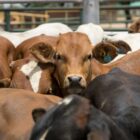
The Hollow Promise of Seaweed Feed Additives for Methane Reduction

Farm Policy for Food, Not Feed

Salmon Aquaculture is Inefficient and Inequitable
Stay informed.
To stay informed of future posts.
- Location ZIP / Postal Code Afghanistan Albania Algeria American Samoa Andorra Angola Anguilla Antarctica Antigua and Barbuda Argentina Armenia Aruba Australia Austria Azerbaijan Bahamas Bahrain Bangladesh Barbados Belarus Belgium Belize Benin Bermuda Bhutan Bolivia Bonaire, Sint Eustatius and Saba Bosnia and Herzegovina Botswana Bouvet Island Brazil British Indian Ocean Territory Brunei Darussalam Bulgaria Burkina Faso Burundi Cabo Verde Cambodia Cameroon Canada Cayman Islands Central African Republic Chad Chile China Christmas Island Cocos Islands Colombia Comoros Congo Congo, Democratic Republic of the Cook Islands Costa Rica Croatia Cuba Curaçao Cyprus Czechia Côte d'Ivoire Denmark Djibouti Dominica Dominican Republic Ecuador Egypt El Salvador Equatorial Guinea Eritrea Estonia Eswatini Ethiopia Falkland Islands Faroe Islands Fiji Finland France French Guiana French Polynesia French Southern Territories Gabon Gambia Georgia Germany Ghana Gibraltar Greece Greenland Grenada Guadeloupe Guam Guatemala Guernsey Guinea Guinea-Bissau Guyana Haiti Heard Island and McDonald Islands Holy See Honduras Hong Kong Hungary Iceland India Indonesia Iran Iraq Ireland Isle of Man Israel Italy Jamaica Japan Jersey Jordan Kazakhstan Kenya Kiribati Korea, Democratic People's Republic of Korea, Republic of Kuwait Kyrgyzstan Lao People's Democratic Republic Latvia Lebanon Lesotho Liberia Libya Liechtenstein Lithuania Luxembourg Macao Madagascar Malawi Malaysia Maldives Mali Malta Marshall Islands Martinique Mauritania Mauritius Mayotte Mexico Micronesia Moldova Monaco Mongolia Montenegro Montserrat Morocco Mozambique Myanmar Namibia Nauru Nepal Netherlands New Caledonia New Zealand Nicaragua Niger Nigeria Niue Norfolk Island North Macedonia Northern Mariana Islands Norway Oman Pakistan Palau Palestine, State of Panama Papua New Guinea Paraguay Peru Philippines Pitcairn Poland Portugal Puerto Rico Qatar Romania Russian Federation Rwanda Réunion Saint Barthélemy Saint Helena, Ascension and Tristan da Cunha Saint Kitts and Nevis Saint Lucia Saint Martin Saint Pierre and Miquelon Saint Vincent and the Grenadines Samoa San Marino Sao Tome and Principe Saudi Arabia Senegal Serbia Seychelles Sierra Leone Singapore Sint Maarten Slovakia Slovenia Solomon Islands Somalia South Africa South Georgia and the South Sandwich Islands South Sudan Spain Sri Lanka Sudan Suriname Svalbard and Jan Mayen Sweden Switzerland Syria Arab Republic Taiwan Tajikistan Tanzania, the United Republic of Thailand Timor-Leste Togo Tokelau Tonga Trinidad and Tobago Tunisia Turkmenistan Turks and Caicos Islands Tuvalu Türkiye US Minor Outlying Islands Uganda Ukraine United Arab Emirates United Kingdom United States Uruguay Uzbekistan Vanuatu Venezuela Viet Nam Virgin Islands, British Virgin Islands, U.S. Wallis and Futuna Western Sahara Yemen Zambia Zimbabwe Åland Islands Country
- IELTS Scores
- Life Skills Test
- Find a Test Centre
- Alternatives to IELTS
- General Training
- Academic Word List
- Topic Vocabulary
- Collocation
- Phrasal Verbs
- Writing eBooks
- Reading eBook
- All eBooks & Courses
- Sample Essays
Animal Rights Essay
This IELTS animal rights essay discusses the exploitation of animals by humans.
People who believe in animal rights think that they should not be treated cruelly, for example in experiments or for sport.
'To exploit' means to benefit from something in an unfair way. Take a look at the question:
A growing number of people feel that animals should not be exploited by people and that they should have the same rights as humans, while others argue that humans must employ animals to satisfy their various needs, including uses for food and research.
Discuss both views and give your opinion.
Discussing 'Two Opinions'
Animals should not be exploited by people and they should have the same rights as humans. Humans must employ animals to satisfy their various needs, including uses for food and research.
In this essay you are being given two opposing opinions to discuss.
This is the first opinion:
- Animals should not be exploited by people and they should have the same rights as humans.
This is the second opinion:
- Humans must employ animals to satisfy their various needs, including uses for food and research.
In this type of essay, you must look at both sides. In other words you need to discuss the arguments FOR animal rights and AGAINST .
You must also ensure you give YOUR opinion.
Organising the Essay
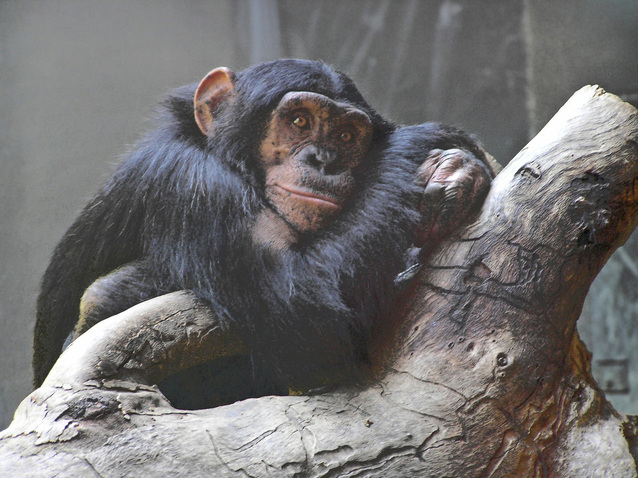
One way to organize an essay like this is to consider both opinions, then give your opinion in a final paragraph ( see this example ) or dedicate a whole final paragraph to your opinion ( see this example ).
Another way to write an essay like this is to also make one of the 'for' or 'against' opinions your opinion as well.
Look at the model animal rights essay below. The second body paragraph discusses the first opinion, but the topic sentence makes it clear that this paragraph is also representing the writers opinion as well:
However, I do not believe these arguments stand up to scrutiny.
This now means that in two body paragraphs you have covered all three parts of the question from the animal rights essay:
1. First opinion 2. Second opinion 3. Your opinion
The advantage of doing it this way rather than having a separate paragraph is that you do not need to come up with new ideas for a new paragraph.
If you have a separate paragraph with your opinion you may find you cannot think of any new ideas or you may end up repeating the same things as in your previous paragraphs.
IELTS Writing Example
You should spend about 40 minutes on this task.
Write about the following topic:
Give reasons for your answer and include any relevant examples from your own experience or knowledge.
Write at least 250 words.
Animal Rights Essay - Model Answer
Animals have always been used by humans in some form to satisfy their needs. However, while some people believe that animals should be treated in the same way humans are and have similar rights, others think that it is more important to use them as we desire for food and medical research.
With regard to the exploitation of animals, people believe it is acceptable for several reasons. Firstly, they think that humans are the most important beings on the planet, and everything must be done to ensure human survival. If this means experimenting on animals so that we can fight and find cures for diseases, then this takes priority over animal suffering. Furthermore, it is believed by some that animals do not feel pain or loss as humans do, so if we have to kill animals for food or other uses, then this is morally acceptable.
However, I do not believe these arguments stand up to scrutiny. To begin, it has been shown on numerous occasions by secret filming in laboratories via animal rights groups that animals feel as much pain as humans do, and they suffer when they are kept in cages for long periods. In addition, a substantial amount of animal research is done for cosmetics, not to find cures for diseases, so this is unnecessary. Finally, it has also been proven that humans can get all the nutrients and vitamins that they need from green vegetables and fruit. Therefore, again, having to kill animals for food is not an adequate argument.
To sum up, although some people argue killing animals for research and food is ethical, I would argue there is sufficient evidence to demonstrate that this is not the case, and, therefore, steps must be taken to improve the rights of animals.
(Words 290)
<<< Back
Next >>>
More Discuss Two Opinion Essays:

Extraterrestrial Life Essay: Should we look for life on other planets?
This extraterrestrial life essay is an IELTS opinion essay where you have to discuss both sides of an issue then give your own opinion.

Sources for Stories Essay: Should parents read to their children?
This sources for stories essay asks for your opinion on the best way for children to get stories. Is it from parents reading to them or other ways?

Childcare Essay: Should family or carers look after young children?
Childcare Essay: In the essay you have to discuss two sides of an argument. The first is that it is better if pre-school children are looked after at home with relatives such as grandparents. The second opinion is that children should be looked after at childcare centres.
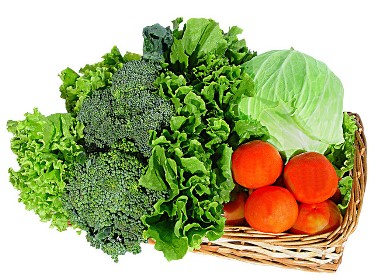
Diet and Health Essay: Who is responsible for diet and health?
Diet and Health Essay for IELTS: This model examines the extent to which individuals or governments should be responsible for health. Read a model answer and useful comments about the essay which will help you to improve your IELTS Score.

IELTS Essays: What is the best way to reduce crime?
IELTS essays online with comments by an IELTS instructor - A writing sample on the topic of reducing crime.

Child Development Essay: What factors influence a child's development?
Child Development Essay for IELTS. The essay is about the factors that affect the way that children develop. It provides you with a model answer and comments on the response to help you know how to improve your band score.

Donating Money to Charity Essay: Where should the money go?
Donating Money to Charity Essay: IELTS model answer to an essay on the topic of giving locally or to national and international charities.

Influence of Scientists or Politicians Essay
Influence of Scientists or Politicians Essay- Model answer for IELTS. Who has had the most influence on our world? In this essay you have to discuss both sides.

IELTS Essay Becoming Independent
This IELTS essay discussed whether people are becoming more independent than they were in the past. This is a question that has come up a few times in the test. This is discussion type essay as you have to discuss both sides of an argument and come to a conclusion.

Zoo Essay: Are zoos cruel or do they protect animals?
This is a recent zoo essay question from the IELTS test (June 2018). Essay about zoos have come up a few times in the IELTS test so it's worth studying same sample questions and sample essays about the topic.
Formal and Informal Education Essay: What age should it start?
This formal and informal education essay is about whether it is best for children to begin their formal education at school when they are 7 rather than much younger.

IELTS Writing Example: What are the aims of a university education?
IELTS writing example essays. This is an essay on the aims of university education. In this essay, two opposing opinions need to be discussed. It is important to understand how to answer this type of question in the IELTS exam.
Any comments or questions about this page or about IELTS? Post them here. Your email will not be published or shared.
Before you go...
Check out the ielts buddy band 7+ ebooks & courses.

Would you prefer to share this page with others by linking to it?
- Click on the HTML link code below.
- Copy and paste it, adding a note of your own, into your blog, a Web page, forums, a blog comment, your Facebook account, or anywhere that someone would find this page valuable.
Band 7+ eBooks
"I think these eBooks are FANTASTIC!!! I know that's not academic language, but it's the truth!"
Linda, from Italy, Scored Band 7.5

IELTS Modules:
Other resources:.
- All Lessons
- Band Score Calculator
- Writing Feedback
- Speaking Feedback
- Teacher Resources
- Free Downloads
- Recent Essay Exam Questions
- Books for IELTS Prep
- Useful Links

Recent Articles
Useful Language for IELTS Graphs
May 16, 24 04:44 AM

Taking a Gap Year
May 14, 24 03:00 PM
IELTS Essay: Loving Wildlife and Nature
May 10, 24 02:36 AM
Important pages
IELTS Writing IELTS Speaking IELTS Listening IELTS Reading All Lessons Vocabulary Academic Task 1 Academic Task 2 Practice Tests
Connect with us
Copyright © 2022- IELTSbuddy All Rights Reserved
IELTS is a registered trademark of University of Cambridge, the British Council, and IDP Education Australia. This site and its owners are not affiliated, approved or endorsed by the University of Cambridge ESOL, the British Council, and IDP Education Australia.
The Rights of Animals by Brigid Brophy [Summary and Answer] - BookReview
In the essay The Rights of Animals, the essayist Brigid Brophy wittily argues one of her favorite causes-the responsibility of the human beings to behave decently towards the animals. She asserts that our relationship to animals is one of ‘unremitting exploitation’ and argues that we ate under obligation to respect their rights and spare them pain and terror.

Summary of the essay The Rights of Animals by Brigid Brophy
Brigid Brophy says that our relationship with animals is continuous exploitation. She wants to preserve and protect the right of animals. She does not want us to kill animals and experiment with them for our selfish happiness.
According to her, people should treat animals as they treat humans. She says that we must not kill animals brutally. We even should not kill violent animals but should preserve them. Animals also feel pain like human beings. Animals also have a soul like us. People should not tame animals to eat.
According to her, many hygienic foods help people to be strong and energetic. Animals should not keep in a circus, instead of doing so, jobless people should be given a physical train of art so that they would involve in productive work.
To sum up, like human beings, animals also have equal rights to live with complete freedom. It is also their home. So, she wants to outlawed killing and making prisons for animals for our happiness. We should think that they have also hearts and souls. Animals are used in the clinical trial. She says that for a clinical trial, we should not kill a large number of animals.
Click here to watch web stories
Frequently asked questions from The Rights of Animals by Brigid Brophy
1. What practices would Brophy like to see outlawed in England? What would you like to see outlawed in Nepal?
Ans : Killing animal practices Brophy would like to see outlawed in England. I would like to see in Nepal that in place of killing and eating animals, people should eat fruit and vegetable. If anybody kills animals, they should be punished strictly.
2. What emotional reactions does she hope to evoke from her readers?
Ans : She hopes to evoke from her readers that we and animals are similar. Like us, they have also hearts and souls.
3. Do you think some members of her audience might have reservations about the writer's proposals?
Ans : I think that some members of her audience do not accept her ideas thinking that they are superior beings and animals are lowly creatures.
4. What is the main idea of the article?
Ans : The main idea of the article is that we are also animals. So we should respect animals. They also have the right to survive on the earth
5. Why should human beings treat animals with more respect?
Ans : Human beings should treat animals with more respect because they have also souls and feel pain like us.
6. How does the writer go about getting her readers to put themselves in the place of animals?
Ans : The writer goes about getting her readers to put themselves in the place of animals by mentioning that they have also souls, and feel pain and agony. They have also sense organs to see, feel and touch
7. How would you as a reader response to this essay?
Ans : I am a vegetarian. Like Brophy, I also think that animals can feel pain and agony. They breathe as we breathe. They have also the soul. Like us, they have also the right to survive on the earth. It is also their home. They should not use in a circus as a matter of taking fun. We should respect them thinking that we are also animals. For a clinical trial of medicine, we should not kill a large number of animals.
8. What is the other side of the issue? How would you argue against agreeing with the writer's arguments? What do you think are the incorrect assumptions the writer has made?
Ans : I think that she has made an incorrect assumption saying that we are also animals. She tries to make us as equal as an animal. I do not believe that we are animals because we can think and have a creative minds. We not only kill the animal but also become a savior of the animals. We tame cats, and dogs and give better life but they cannot tame us. We respect cows and feed them. In this regard, we are not similar to an animal.
9. There was a practice of killing street dogs by the Kathmandu Municipality in the past. Now they have stopped doing it. Do you think the old practice was right? Why? Why not?
Ans : As a humanist, I think that the old practice of killing street dogs is not good. In the past, they were killed in massive numbers especially in Kathmandu city thinking that they can go mad and bite us. As a result, they transmit rabies. Instead of thinking of rabies, at that time, it would have been better to provide rabies vaccines to them. Street dogs are not as dangerous as cobra because if they get vaccines they will not harm us.
Contact Form

IMAGES
VIDEO
COMMENTS
Steven M. Wise. Animal rights, moral or legal entitlements attributed to nonhuman animals, usually because of the complexity of their cognitive, emotional, and social lives or their capacity to experience physical or emotional pain or pleasure. Historically, different views of the scope of animal rights have.
Animal rights aim to do something similar, only for non-human animals. Animal rights come into direct opposition with animal exploitation, which includes animals used by humans for a variety of reasons, be it for food, as experimental objects, or even pets. Animal rights can also be violated when it comes to human destruction of animal habitats.
The modern animal rights movement in the United States saw a major milestone in the 1970s with the publication of Peter Singer's "Animal Liberation," in which he argued that it was ethically important that nonhuman animals feel pain, and that this fact demanded far more equal treatment of nonhuman animals and humans. He also popularized the term "speciesism" to describe what happens ...
1. Introduction: The Need for Legal Animal Rights Theory. Legal animal rights are on the horizon, and there is a need for a legal theory of animal rights—that is, a theory of animal rights as legal rights. While there is a diverse body of moral and political theories of animal rights, 1 the nature and conceptual foundations of legal animal rights remain remarkably underexplored.
The essays succeed at exploring, critiquing, and expanding upon Regan's work in a way that is both rigorous and detailed, while accessible to those new to Regan or the animal rights literature. The book has three parts. Part 1 focuses on the theoretical basis of animal rights, and responses to objections to animal rights.
Why do we prioritize human rights over those of other species? Philosopher Peter Singer dives into what he calls "speciesism," the root of the widely ignored mistreatment of animals around the world, from factory farms to product-testing facilities. He makes the case for ending the commercial exploitation of animals for food and invites everyone to reexamine the environmental and moral weight ...
Cass R. Sunstein, "The Rights of Animals: A Very Short Primer" (Public Law & Legal Theory Working Papers No. 30, 2002). This Working Paper is brought to you for free and open access by the Working Papers at Chicago Unbound. It has been accepted for inclusion in Public Law and Legal Theory Working Papers by an authorized administrator of Chicago ...
It shows the range of possible positions concerning the animal rights issue and explores what issues, of theory or fact, separate reasonable people. The chapter claims that in at least some sense, almost everyone believes in animal rights, and that the real question is about what the phrase 'animal rights' actually means.
Abstract. Animal Rights: A Very Short Introduction explores the implications for how we should treat animals in connection with our diet, zoos, and research. Most people are opposed to cruelty and sense that animals have moral significance. At the same time, traditional views that sanction animal use with few constraints have heavily influenced beliefs and everyday practices.
Parshvanatha, the 23rd Tirthankara, revived Jainism and ahimsa in the 9th century BCE, which led to a radical animal-rights movement in South Asia. The c. 5th-century CE Tamil scholar Valluvar, in his Tirukkural, taught ahimsa and moral vegetarianism as personal virtues. The plaque in this statue of Valluvar at an animal sanctuary in South India describes the Kural's teachings on ahimsa and ...
They do, just as human animals do. Without rights that are enshrined in law, there is nothing to stop up being harmed and exploited. Animals can suffer, like us, they have personalities and preferences like us, and they do not wish to be harmed, like us. Their rights should not be based on a human perception of their intelligence or worth.
Animal Rights Essay: Main Body. The main body is a place for you to argue your position. One paragraph equals one argument. In informative essays, replace argumentation with facts. Start each section with a topical sentence consisting of a general truth. Then give some explanation and more specific points.
The Importance of Animal Rights Essay. Animal rights are a matter of active debate in society nowadays since there are many related issues that, being unresolved, may endanger many creatures inhabiting the planet. Animals play a significant part in human lives, which is why humanity puts much effort into protecting them, creating various ...
Singer's philosophy later influenced the 1980 founding of the nation's largest animal rights organization, People for the Ethical Treatment of Animals. In 1983, philosopher Tom Regan's seminal treatise The Case for Animal Rights approached the question of animal rights by building upon the work of Immanuel Kant. Regan advanced a ...
ALL ANIMALS ARE EQUAL. by Peter Singer. Ira. W. DeCamp Professor of Bioethics, University Center for Human Values, Princeton University. Animal Rights and Human Obligations, 2nd edition, New Jersey, 1989. In recent years a number of oppressed groups have campaigned vigorously for equality. The classic instance is the Black Liberation movement ...
American philosopher Tom Regan developed an animal rights theory, which he illustrates in his now-famous 1983 book, The Case for Animal Rights. He refers to this moral standard as the Rights View. In short, the Rights View seeks to reevaluate the widely-held view of animals as resources by identifying the common values that humans and animals ...
In this essay you are being given two opposing opinions to discuss. This is the first opinion: Animals should not be exploited by people and they should have the same rights as humans. This is the second opinion: Humans must employ animals to satisfy their various needs, including uses for food and research. In this type of essay, you must look ...
The book The Case for Animal Rights, written by American philosopher Tom Regan (1938-2017), contends that nonhuman animals (as he refers to domesticated animals) do have rights. Regan's book was ...
1462 Words. 6 Pages. Open Document. In "The Case for Animal Rights" written by Tom Regan, the author analyzes reasons for why all beings should have rights, but argues in particular why animals should have basic rights, like humans. "I regard myself as an advocate of animal rights- as a part of the animal rights movement" (Regan 337).
plants. This is perverse from both an animal rights and animal welfare perspective: The animals have moral considerability, but the plants have no competing claims to consider (Regan 1983, 362). To take a more extreme case, Sapontzis (1987, 237) and Rakowski (1991, 363-367) defend an animal rights case for eliminating
Essay Competition. The Cambridge Centre for Animal Rights Law organises an annual essay competition in the field of animal rights law. The aim of this competition is to encourage students to explore the fascinating questions that animals rights raise, and to discuss these questions in an original piece of writing that may inspire them to engage further with the topic in the future.
Summary of the essay The Rights of Animals by Brigid Brophy. Brigid Brophy says that our relationship with animals is continuous exploitation. She wants to preserve and protect the right of animals. She does not want us to kill animals and experiment with them for our selfish happiness. According to her, people should treat animals as they ...